List of natural satellites
The Solar System's eight planets, and its nine most likely dwarf planets, are known to be orbited by at least 297 natural satellites, or moons. At least 19 of them are large enough to be gravitationally rounded; of these, all are covered by a crust of ice except for Earth's Moon and Jupiter's Io.[1] Several of the largest ones are in hydrostatic equilibrium and would therefore be considered dwarf planets or planets if they were in direct orbit around the Sun and not in their current states (orbiting planets or dwarf planets).
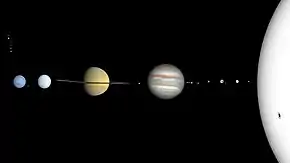 |
| Objects |
|---|
| Lists |
| Planets |
|
|
Moons are classed in two separate categories according to their orbits: regular moons, which have prograde orbits (they orbit in the direction of their planets' rotation) and lie close to the plane of their equators, and irregular moons, whose orbits can be pro- or retrograde (against the direction of their planets' rotation) and often lie at extreme angles to their planets' equators. Irregular moons are probably minor planets that have been captured from surrounding space. Most irregular moons are less than 10 kilometres (6.2 mi) in diameter.
The earliest published discovery of a moon other than Earth's was by Galileo Galilei, who discovered the four Galilean moons orbiting Jupiter in 1610. Over the following three centuries only a few more moons were discovered. Missions to other planets in the 1970s, most notably the Voyager 1 and 2 missions, saw a surge in the number of moons detected, and observations since the year 2000, using mostly large, ground-based optical telescopes, have discovered many more, all of which are irregular.
Moons by primary
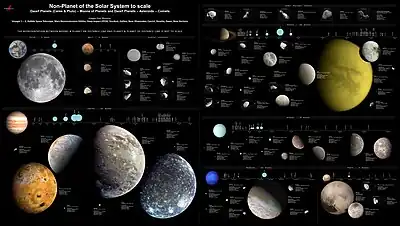
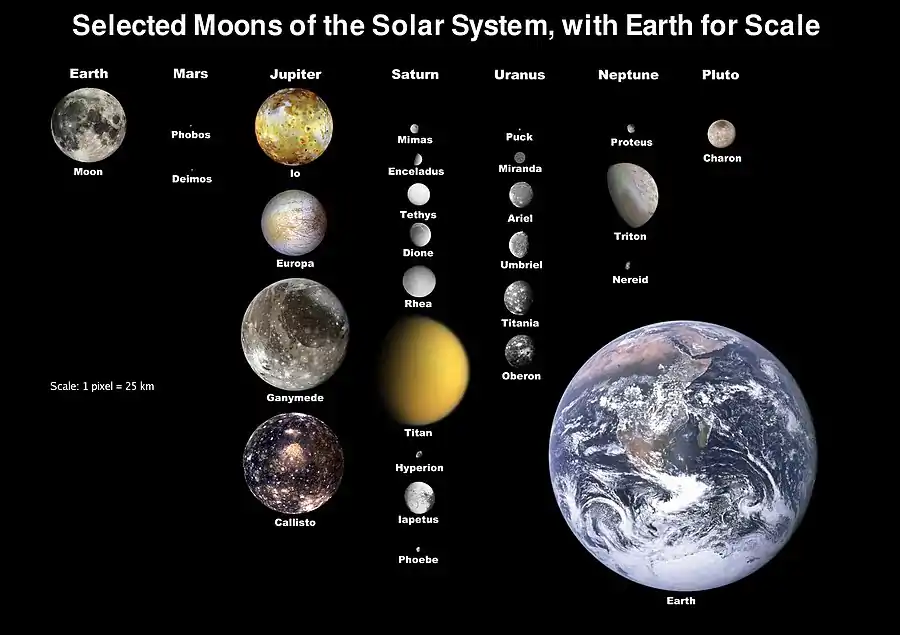
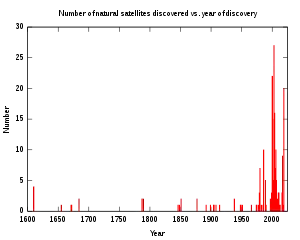
Mercury, the smallest and innermost planet, has no moons, or at least none that can be detected to a diameter of 1.6 km (1.0 mi).[2] For a very short time in 1974, Mercury was thought to have a moon.
Venus also has no moons,[3] though reports of a moon around Venus have circulated since the 17th century.
Earth has one Moon, the largest moon of any rocky planet in the Solar System. Earth also has more than 20 known co-orbitals, including the asteroids 3753 Cruithne and 469219 Kamoʻoalewa, and the occasional temporary satellite, like 2020 CD3; however, since they do not permanently orbit Earth, they are not considered moons. (See Other moons of Earth and Quasi-satellite.)
Mars has two known moons, Phobos and Deimos ("fear" and "dread", after attendants of Ares, the Greek god of war, equivalent to the Roman Mars). Searches for more satellites have been unsuccessful, putting the maximum radius of any other satellites at 90 m (100 yd).[4]
Jupiter has 95 moons with known orbits; 72 of them have received permanent designations, and 57 have been named. Its eight regular moons are grouped into the planet-sized Galilean moons and the far smaller Amalthea group. They were named after lovers of Zeus, the Greek equivalent of Jupiter. Among them is Ganymede, the largest and most massive moon in the Solar System. Its 87 known irregular moons are organized into two categories: prograde and retrograde. The prograde satellites consist of the Himalia group and three others in groups of one. The retrograde moons are grouped into the Carme, Ananke and Pasiphae groups.
Saturn has 146 moons with known orbits; 66 of them have received permanent designations, and 63 have been named. Most of them are quite small. Seven moons are large enough to be in hydrostatic equilibrium, including Titan, the second largest moon in the Solar System. Including these large moons, 24 of Saturn's moons are regular, and traditionally named after Titans or other figures associated with the mythological Saturn. The remaining 122 are irregular, and classified by their orbital characteristics into Inuit, Norse, and Gallic groups, and their names are chosen from the corresponding mythologies the groups are named after. The rings of Saturn are made up of icy objects ranging in size from one centimetre to hundreds of metres, each of which is on its own orbit about the planet. Thus, a precise number of Saturnian moons cannot be given, as there is no objective boundary between the countless small anonymous objects that form Saturn's ring system and the larger objects that have been named as moons. At least 150 "moonlets" embedded in the rings have been detected by the disturbance they create in the surrounding ring material, though this is thought to be only a small sample of the total population of such objects.
Uranus has 27 known moons, five of which are massive enough to have achieved hydrostatic equilibrium. There are 13 moons that orbit within Uranus's ring system, and another nine outer irregular moons. Unlike most planetary moons, which are named from antiquity, all the moons of Uranus are named after characters from the works of Shakespeare and Alexander Pope's work The Rape of the Lock.
Neptune has 14 known moons; the largest, Triton, accounts for more than 99.5 percent of all the mass orbiting the planet. Triton is large enough to have achieved hydrostatic equilibrium, but, uniquely for a large moon, has a retrograde orbit, suggesting it was a dwarf planet that was captured. Neptune also has seven known inner regular satellites, and six outer irregular satellites.
Pluto, a dwarf planet, has five moons. Its largest moon Charon, named after the ferryman who took souls across the River Styx, is more than half as large as Pluto itself, and large enough to orbit a point outside Pluto's surface. In effect, each orbits the other, forming a binary system informally referred to as a double-dwarf-planet. Pluto's four other moons, Nix, Hydra, Kerberos and Styx are far smaller and orbit the Pluto–Charon system.[5]
Among the other dwarf planets, Ceres has no known moons. It is 90 percent certain that Ceres has no moons larger than 1 km in size, assuming that they would have the same albedo as Ceres itself.[6] Eris has one large known moon, Dysnomia. Accurately determining its size is difficult: one indicative estimate of its radius is 350±57.5 km.[7]
Two objects were named as dwarf planets, under the expectation that they would prove to be so (though this remains uncertain). Haumea has two moons, Hiʻiaka and Namaka, of radii ~195 and ~100 km, respectively.[8] Makemake has one moon, discovered in April 2016.
A number of other objects in the Kuiper belt and scattered disk may turn out to be dwarf planets. Orcus, Quaoar, Gonggong, and Sedna are generally agreed to be dwarf planets among astronomers, and all but Sedna are known to have moons.[9] A number of other smaller objects, such as Salacia, Varda, and 2013 FY27, also have moons, although their dwarf planethood is more doubtful. This list includes all objects with a best estimated diameter above 700 km, including 2003 AZ84 whose satellite has not been seen since its initial discovery.
As of October 2022, 365 asteroid moons and 128 trans-Neptunian moons (including those of Pluto and the other dwarf planets) had been discovered.[10]
Summary – number of moons Planet Mercury Venus Earth Mars Jupiter Saturn Uranus Neptune Number of moons 0 0 1 2 95 146 27 14
Likely dwarf planets Ceres Orcus Pluto Haumea Quaoar Makemake Gonggong Eris Sedna Number of moons 0 1 5 2 1 1 1 1 0
Possible dwarf planet candidates 2003 AZ84 Ixion Salacia 2002 MS4 Varda 2002 AW197 2013 FY27 Number of moons 1 0 1 0 1 0 1
Minor planet See list
Due to Earth's varying distance from these planets (as well as their distance to the Sun), the limits at which we are able to detect new moons are very inconsistent. As the below graph demonstrates, the absolute magnitude (total inherent brightness, abbreviated H) of moons we have detected around planets peaks at H = 17 for Jupiter, H = 16 for Saturn, H = 13 for Uranus, and H = 11 for Neptune. Smaller moons may (and most likely do) exist around each of these planets, but are currently undetectable from Earth. Although spacecraft have visited all of these planets, Earth-based telescopes continue to outperform them in moon-detection ability due to their greater availability for wide-field surveys.
List
This is a list of the recognized moons of the planets and of the largest potential dwarf planets of the Solar System, ordered by their official Roman numeral designations. Moons that do not yet have official Roman numeral designations (because their orbits are not yet known well enough) are listed after those that do.
The 19 moons that are known to be large enough to have been rounded by their own gravity are listed in bold. The seven largest moons, which are larger than any of the known dwarf planets, are listed in bold and italic. Sidereal period differs from semi-major axis because a moon's speed depends both on the mass of its primary and its distance from it.
| Satellites of planets | ||
|---|---|---|
| Satellite of Earth | Satellites of Jupiter | Satellites of Uranus |
| Satellites of Mars | Satellites of Saturn | Satellites of Neptune |
| Satellites of generally agreed dwarf planets | ||
| Satellite of Orcus | Satellites of Pluto | Satellites of Haumea |
| Satellite of Quaoar | Satellite of Makemake | Satellite of Gonggong |
| Satellite of Eris | ||
| Satellites of other dwarf planet candidates | ||
| Satellite of 2003 AZ84 | Satellite of Salacia | Satellite of Varda |
| Satellite of 2013 FY27 | ||
| Name | Image | Parent | Numeral | Mean radius (km) | Orbital semi-major axis (km) | Sidereal period (d) (r = retrograde) |
Discovery year | Year Announced | Discovered by | Notes | Ref(s) |
|---|---|---|---|---|---|---|---|---|---|---|---|
| Moon | Earth | I (1) | 1,738 | 384,399 | 27.321582 | Prehistoric | Prehistory | — | Synchronous rotation (Binary) | [11] | |
| Phobos | Mars | I (1) | 11.267 | 9,380 | 0.319 | 1877 | 1877 | Hall | [12][13][14] | ||
| Deimos |  | Mars | II (2) | 6.2±0.18 | 23,460 | 1.262 | 1877 | 1877 | Hall | [12][13][14] | |
| Io |  | Jupiter | I (1) | 1,821.6±0.5 | 421,800 | 1.769 | 1610 | 1610 | Galileo | Main-group moon (Galilean) | [14][15] |
| Europa |  | Jupiter | II (2) | 1,560.8±0.5 | 671,100 | 3.551 | 1610 | 1610 | Galileo | Main-group moon (Galilean) | [14][15] |
| Ganymede | 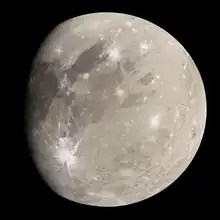 | Jupiter | III (3) | 2,634.1±0.3 | 1,070,400 | 7.155 | 1610 | 1610 | Galileo | Main-group moon (Galilean) | [14][15] |
| Callisto |  | Jupiter | IV (4) | 2,410.3±1.5 | 1,882,700 | 16.69 | 1610 | 1610 | Galileo | Main-group moon (Galilean) | [14][15] |
| Amalthea | Jupiter | V (5) | 83.5±2 | 181,400 | 0.498 | 1892 | 1892 | Barnard | Inner moon (Amalthea) | [13][14][16] | |
| Himalia |  | Jupiter | VI (6) | 69.8 | 11,461,000 | 250.56 | 1904 | 1905 | Perrine | Prograde irregular (Himalia) | [13][14][17][18] |
| Elara | 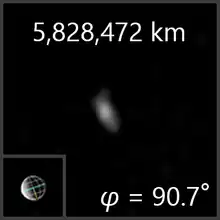 | Jupiter | VII (7) | 43 | 11,741,000 | 259.64 | 1905 | 1905 | Perrine | Prograde irregular (Himalia) | [13][14][19] |
| Pasiphae | Jupiter | VIII (8) | 30 | 23,624,000 | 743.63 (r) | 1908 | 1908 | Melotte | Retrograde irregular (Pasiphae) | [13][14][20] | |
| Sinope | 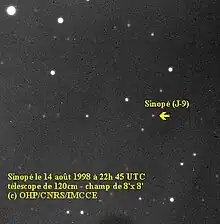 | Jupiter | IX (9) | 19 | 23,939,000 | 758.90 (r) | 1914 | 1914 | Nicholson | Retrograde irregular (Pasiphae) | [13][14][21] |
| Lysithea | 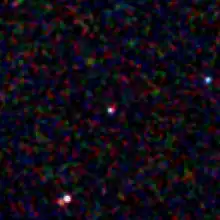 | Jupiter | X (10) | 18 | 11,717,000 | 259.20 | 1938 | 1938 | Nicholson | Prograde irregular (Himalia) | [13][14][22] |
| Carme |  | Jupiter | XI (11) | 23 | 23,404,000 | 734.17 (r) | 1938 | 1938 | Nicholson | Retrograde irregular (Carme) | [13][14][22] |
| Ananke |  | Jupiter | XII (12) | 14 | 21,276,000 | 629.77 (r) | 1951 | 1951 | Nicholson | Retrograde irregular (Ananke) | [13][14][23] |
| Leda | 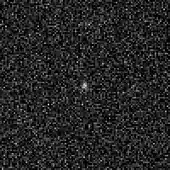 | Jupiter | XIII (13) | 10 | 11,165,000 | 240.92 | 1974 | 1974 | Kowal | Prograde irregular (Himalia) | [13][14][24] |
| Thebe | 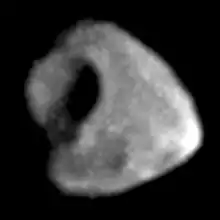 | Jupiter | XIV (14) | 49.3±2.0 | 221,900 | 0.675 | 1979 | 1980 | Synnott (Voyager 1) | Inner moon (Amalthea) | [13][14][25] |
| Adrastea | Jupiter | XV (15) | 8.2±2.0 | 129,000 | 0.298 | 1979 | 1979 | Jewitt, Danielson (Voyager 1) | Inner moon (Amalthea) | [13][14][26] | |
| Metis | Jupiter | XVI (16) | 21.5±2.0 | 128,000 | 0.295 | 1979 | 1980 | Synnott (Voyager 1) | Inner moon (Amalthea) | [13][14][27] | |
| Callirrhoe | Jupiter | XVII (17) | 4.5 | 24,103,000 | 758.77 (r) | 1999 | 2000 | Scotti, Spahr, McMillan, Larsen, Montani, Gleason, Gehrels | Retrograde irregular (Pasiphae) | [13][14][28] | |
| Themisto |  | Jupiter | XVIII (18) | 4 | 7,284,000 | 130.02 | 1975/2000 | 1975/2000 | Kowal and Roemer (original); Sheppard, Jewitt, Fernández, Magnier (rediscovery) | Prograde irregular (Themisto) | [13][14][29][30] |
| Megaclite | Jupiter | XIX (19) | 2.7 | 23,493,000 | 752.86 (r) | 2000 | 2001 | Sheppard, Jewitt, Fernández, Magnier, Dahm, Evans | Retrograde irregular (Pasiphae) | [13][14][31] | |
| Taygete | Jupiter | XX (20) | 2.5 | 23,280,000 | 732.41 (r) | 2000 | 2001 | Sheppard, Jewitt, Fernández, Magnier, Dahm, Evans | Retrograde irregular (Carme) | [13][14][31] | |
| Chaldene | Jupiter | XXI (21) | 1.9 | 23,100,000 | 723.72 (r) | 2000 | 2001 | Sheppard, Jewitt, Fernández, Magnier, Dahm, Evans | Retrograde irregular (Carme) | [13][14][31] | |
| Harpalyke | Jupiter | XXII (22) | 2.2 | 20,858,000 | 623.32 (r) | 2000 | 2001 | Sheppard, Jewitt, Fernández, Magnier, Dahm, Evans | Retrograde irregular (Ananke) | [13][14][31] | |
| Kalyke | Jupiter | XXIII (23) | 2.6 | 23,483,000 | 742.06 (r) | 2000 | 2001 | Sheppard, Jewitt, Fernández, Magnier, Dahm, Evans | Retrograde irregular (Carme) | [13][14][31] | |
| Iocaste | Jupiter | XXIV (24) | 2.6 | 21,060,000 | 631.60 (r) | 2000 | 2001 | Sheppard, Jewitt, Fernández, Magnier, Dahm, Evans | Retrograde irregular (Ananke) | [13][14][31] | |
| Erinome | Jupiter | XXV (25) | 1.6 | 23,196,000 | 728.46 (r) | 2000 | 2001 | Sheppard, Jewitt, Fernández, Magnier, Dahm, Evans | Retrograde irregular (Carme) | [13][14][31] | |
| Isonoe | Jupiter | XXVI (26) | 1.9 | 23,155,000 | 726.23 (r) | 2000 | 2001 | Sheppard, Jewitt, Fernández, Magnier, Dahm, Evans | Retrograde irregular (Carme) | [13][14][31] | |
| Praxidike | Jupiter | XXVII (27) | 3.5 | 20,908,000 | 625.39 (r) | 2000 | 2001 | Sheppard, Jewitt, Fernández, Magnier, Dahm, Evans | Retrograde irregular (Ananke) | [13][14][31] | |
| Autonoe | Jupiter | XXVIII (28) | 2 | 24,046,000 | 760.95 (r) | 2001 | 2002 | Sheppard, Jewitt, Kleyna | Retrograde irregular (Pasiphae) | ||
| Thyone | Jupiter | XXIX (29) | 2 | 20,939,000 | 627.21 (r) | 2001 | 2002 | Sheppard, Jewitt, Kleyna | Retrograde irregular (Ananke) | [13][14][32] | |
| Hermippe | Jupiter | XXX (30) | 2 | 21,131,000 | 633.9 (r) | 2001 | 2002 | Sheppard, Jewitt, Kleyna | Retrograde irregular (Ananke) | [13][14][32] | |
| Aitne | Jupiter | XXXI (31) | 1.5 | 23,229,000 | 730.18 (r) | 2001 | 2002 | Sheppard, Jewitt, Kleyna | Retrograde irregular (Carme) | [13][14][32] | |
| Eurydome | Jupiter | XXXII (32) | 1.5 | 22,865,000 | 717.33 (r) | 2001 | 2002 | Sheppard, Jewitt, Kleyna | Retrograde irregular (Pasiphae) | [13][14][32] | |
| Euanthe | Jupiter | XXXIII (33) | 1.5 | 20,797,000 | 620.49 (r) | 2001 | 2002 | Sheppard, Jewitt, Kleyna | Retrograde irregular (Ananke) | [13][14][32] | |
| Euporie | Jupiter | XXXIV (34) | 1 | 19,304,000 | 550.74 (r) | 2001 | 2002 | Sheppard, Jewitt, Kleyna | Retrograde irregular (Ananke) | [13][14][32] | |
| Orthosie | Jupiter | XXXV (35) | 1 | 20,720,000 | 622.56 (r) | 2001 | 2002 | Sheppard, Jewitt, Kleyna | Retrograde irregular (Ananke) | [13][14][32] | |
| Sponde | Jupiter | XXXVI (36) | 1 | 23,487,000 | 748.34 (r) | 2001 | 2002 | Sheppard, Jewitt, Kleyna | Retrograde irregular (Pasiphae) | [13][14][32] | |
| Kale | Jupiter | XXXVII (37) | 1 | 23,217,000 | 729.47 (r) | 2001 | 2002 | Sheppard, Jewitt, Kleyna | Retrograde irregular (Carme) | [13][14][32] | |
| Pasithee | Jupiter | XXXVIII (38) | 1 | 23,004,000 | 719.44 (r) | 2001 | 2002 | Sheppard, Jewitt, Kleyna | Retrograde irregular (Carme) | [13][14][32] | |
| Hegemone | Jupiter | XXXIX (39) | 1.5 | 23,577,000 | 739.88 (r) | 2003 | 2003 | Sheppard, Jewitt, Kleyna, Fernández | Retrograde irregular (Pasiphae) | [13][14] | |
| Mneme | 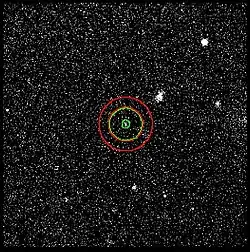 | Jupiter | XL (40) | 1 | 21,035,000 | 620.04 (r) | 2003 | 2003 | Gladman, Allen | Retrograde irregular (Ananke) | [13][14] |
| Aoede | Jupiter | XLI (41) | 2 | 23,980,000 | 761.50 (r) | 2003 | 2003 | Sheppard, Jewitt, Kleyna, Fernández, Hsieh | Retrograde irregular (Pasiphae) | [13][14] | |
| Thelxinoe | Jupiter | XLII (42) | 1 | 21,164,000 | 628.09 (r) | 2003 | 2004 | Sheppard, Jewitt, Kleyna, Gladman, Kavelaars, Petit, Allen | Retrograde irregular (Ananke) | [13][14] | |
| Arche | Jupiter | XLIII (43) | 1.5 | 23,355,000 | 731.95 (r) | 2002 | 2002 | Sheppard, Meech, Hsieh, Tholen, Tonry | Retrograde irregular (Carme) | [13][14][32] | |
| Kallichore | Jupiter | XLIV (44) | 1 | 23,288,000 | 728.73 (r) | 2003 | 2003 | Sheppard, Jewitt, Kleyna, Fernández | Retrograde irregular (Carme) | [13][14] | |
| Helike | Jupiter | XLV (45) | 2 | 21,069,000 | 626.32 (r) | 2003 | 2003 | Sheppard, Jewitt, Kleyna, Fernández, Hsieh | Retrograde irregular (Ananke) | [13][14] | |
| Carpo | Jupiter | XLVI (46) | 1.5 | 17,058,000 | 456.30 | 2003 | 2003 | Sheppard, Gladman, Kavelaars, Petit, Allen, Jewitt, Kleyna | Prograde irregular (Carpo) | [13][14] | |
| Eukelade | Jupiter | XLVII (47) | 2 | 23,328,000 | 730.47 (r) | 2003 | 2003 | Sheppard, Jewitt, Kleyna, Fernández, Hsieh | Retrograde irregular (Carme) | [13][14] | |
| Cyllene | Jupiter | XLVIII (48) | 1 | 23,809,000 | 752 (r) | 2003 | 2003 | Sheppard, Jewitt, Kleyna | Retrograde irregular (Pasiphae) | [13][14] | |
| Kore | Jupiter | XLIX (49) | 1 | 24,543,000 | 779.17 (r) | 2003 | 2003 | Sheppard, Jewitt, Kleyna | Retrograde irregular (Pasiphae) | [13][14] | |
| Herse | Jupiter | L (50) | 1 | 22,983,000 | 714.51 (r) | 2003 | 2003 | Gladman, Sheppard, Jewitt, Kleyna, Kavelaars, Petit, Allen | Retrograde irregular (Carme) | [13][14] | |
| S/2010 J 1 | Jupiter | LI (51) | 1 | 23,314,300 | 723.2 (r) | 2010 | 2011 | Jacobson, Brozović, Gladman, Alexandersen | Retrograde irregular (Carme) | [33] | |
| S/2010 J 2 | Jupiter | LII (52) | 0.5 | 20,307,200 | 588.1 (r) | 2010 | 2011 | Veillet | Retrograde irregular (Ananke) | [33] | |
| Dia | Jupiter | LIII (53) | 2 | 12,118,000 | 287.0 | 2000 | 2001 | Sheppard, Jewitt, Kleyna, Fernández, Hsieh | Prograde irregular (Himalia) | [33] | |
| S/2016 J 1 | Jupiter | LIV (54) | 1 | 20,595,500 | 602.7 (r) | 2016 | 2017 | Sheppard | Retrograde irregular (Ananke) | [33] | |
| S/2003 J 18 | Jupiter | LV (55) | 1 | 20,274,000 | 588.0 (r) | 2003 | 2003 | Gladman, Sheppard, Jewitt, Kleyna, Kavelaars, Petit, Allen | Retrograde irregular (Ananke) | [33] | |
| S/2011 J 2 | Jupiter | LVI (56) | 0.5 | 23,329,700 | 726.8 (r) | 2011 | 2012 | Sheppard | Retrograde irregular (Pasiphae) | [33] | |
| Eirene | Jupiter | LVII (57) | 2 | 23,731,800 | 759.7 (r) | 2003 | 2003 | Sheppard, Jewitt, Kleyna, Fernández, Hsieh | Retrograde irregular (Carme) | [33] | |
| Philophrosyne | Jupiter | LVIII (58) | 1 | 22,820,000 | 701.3 (r) | 2003 | 2003 | Sheppard, Jewitt, Kleyna, Fernández | Retrograde irregular (Pasiphae) | [33] | |
| S/2017 J 1 | Jupiter | LIX (59) | 2 | 23,484,000 | 734.2 (r) | 2017 | 2017 | Sheppard | Retrograde irregular (Pasiphae) | [33] | |
| Eupheme | Jupiter | LX (60) | 1 | 21,199,710 | 627.8 (r) | 2003 | 2003 | Sheppard, Jewitt, Kleyna, Fernández, Hsieh | Retrograde irregular (Ananke) | [33] | |
| S/2003 J 19 | Jupiter | LXI (61) | 1 | 22,757,000 | 697.6 (r) | 2003 | 2003 | Gladman, Sheppard, Jewitt, Kleyna, Kavelaars, Petit, Allen | Retrograde irregular (Carme) | [33] | |
| Valetudo | Jupiter | LXII (62) | 0.5 | 18,928,100 | 532.0 | 2016 | 2018 | Sheppard | Prograde irregular (Valetudo) | [33] | |
| S/2017 J 2 | Jupiter | LXIII (63) | 1 | 23,241,000 | 723.8 (r) | 2017 | 2018 | Sheppard | Retrograde irregular (Carme) | [33] | |
| S/2017 J 3 | Jupiter | LXIV (64) | 1 | 20,639,300 | 605.8 (r) | 2017 | 2018 | Sheppard | Retrograde irregular (Ananke) | [33] | |
| Pandia | Jupiter | LXV (65) | 1.5 | 11,494,800 | 251.8 | 2017 | 2018 | Sheppard | Prograde irregular (Himalia) | [33] | |
| S/2017 J 5 | Jupiter | LXVI (66) | 1 | 23,169,400 | 720.5 (r) | 2017 | 2018 | Sheppard | Retrograde irregular (Carme) | [33] | |
| S/2017 J 6 | Jupiter | LXVII (67) | 1 | 22,394,700 | 684.7 (r) | 2017 | 2018 | Sheppard | Retrograde irregular (Pasiphae) | [33] | |
| S/2017 J 7 | Jupiter | LXVIII (68) | 1 | 20,571,500 | 602.8 (r) | 2017 | 2018 | Sheppard | Retrograde irregular (Ananke) | [33] | |
| S/2017 J 8 | Jupiter | LXIX (69) | 0.5 | 23,174,400 | 720.7 (r) | 2017 | 2018 | Sheppard | Retrograde irregular (Carme) | [33] | |
| S/2017 J 9 | Jupiter | LXX (70) | 1 | 21,430,000 | 640.9 (r) | 2017 | 2018 | Sheppard | Retrograde irregular (Ananke) | [33] | |
| Ersa | Jupiter | LXXI (71) | 1.5 | 11,453,000 | 250.4 | 2018 | 2018 | Sheppard | Prograde irregular (Himalia) | [33] | |
| S/2011 J 1 | Jupiter | LXXII (72) | 0.5 | 20,155,300 | 580.7 (r) | 2011 | 2012 | Sheppard | Retrograde irregular (Carme) | [33] | |
| S/2003 J 2 | Jupiter | — | 1 | 20,554,400 | 602.02 (r) | 2003 | 2003 | Sheppard, Jewitt, Kleyna, Fernández, Hsieh | Retrograde irregular (Ananke) | [13][14] | |
| S/2003 J 4 | Jupiter | — | 1 | 22,048,600 | 668.85 (r) | 2003 | 2003 | Sheppard, Jewitt, Kleyna, Fernández, Hsieh | Retrograde irregular (Pasiphae) | [13][14] | |
| S/2003 J 9 | Jupiter | — | 0.5 | 24,168,700 | 767.6 (r) | 2003 | 2003 | Sheppard, Jewitt, Kleyna, Fernández | Retrograde irregular (Carme) | [13][34] | |
| S/2003 J 10 | Jupiter | — | 1 | 22,896,000 | 707.78 (r) | 2003 | 2003 | Sheppard, Jewitt, Kleyna, Fernández | Retrograde irregular (Carme?) | [13][14] | |
| S/2003 J 12 | Jupiter | — | 0.5 | 21,557,700 | 646.64 (r) | 2003 | 2003 | Sheppard, Jewitt, Kleyna, Fernández | Retrograde irregular (Ananke) | [13][14] | |
| S/2003 J 16 | Jupiter | — | 1 | 20,512,500 | 600.18 (r) | 2003 | 2003 | Gladman, Sheppard, Jewitt, Kleyna, Kavelaars, Petit, Allen | Retrograde irregular (Ananke) | [13][35] | |
| S/2003 J 23 | Jupiter | — | 1 | 24,678,100 | 792.00 (r) | 2003 | 2004 | Sheppard, Jewitt, Kleyna, Fernández | Retrograde irregular (Pasiphae) | [13][14] | |
| S/2003 J 24 | Jupiter | — | 1.5 | 23,088,000 | 715.4 (r) | 2003 | 2021 | Sheppard, Jewitt, Kleyna, Gladman, Veillet | Retrograde irregular (Carme) | [36] | |
| S/2011 J 3 | Jupiter | — | 1.5 | 11,797,200 | 261.77 | 2011 | 2022 | Sheppard | Prograde irregular (Himalia) | [37] | |
| S/2016 J 3 | Jupiter | — | 1 | 22,213,500 | 676.37 (r) | 2016 | 2023 | Sheppard | Retrograde irregular (Carme) | [38] | |
| S/2016 J 4 | Jupiter | — | 1 | 23,664,100 | 743.69 (r) | 2016 | 2023 | Sheppard | Retrograde irregular (Pasiphae) | [39] | |
| S/2018 J 2 | Jupiter | — | 1.5 | 11,467,500 | 250.88 | 2018 | 2022 | Sheppard | Prograde irregular (Himalia) | [40] | |
| S/2018 J 3 | Jupiter | — | 0.5 | 22,826,600 | 704.56 (r) | 2018 | 2023 | Sheppard | Retrograde irregular (Carme) | [41] | |
| S/2018 J 4 | Jupiter | — | 1 | 16,504,300 | 433.16 | 2018 | 2023 | Sheppard | Prograde irregular (Carpo) | [42] | |
| S/2021 J 1 | Jupiter | — | 0.5 | 20,667,200 | 606.99 (r) | 2021 | 2023 | Sheppard | Retrograde irregular (Ananke) | [43] | |
| S/2021 J 2 | Jupiter | — | 0.5 | 21,140,600 | 627.96 (r) | 2021 | 2023 | Sheppard | Retrograde irregular (Ananke) | [44] | |
| S/2021 J 3 | Jupiter | — | 1 | 21,495,700 | 643.85 (r) | 2021 | 2023 | Sheppard | Retrograde irregular (Ananke) | [45] | |
| S/2021 J 4 | Jupiter | — | 0.5 | 22,946,700 | 710.13 (r) | 2021 | 2023 | Sheppard | Retrograde irregular (Carme) | [46] | |
| S/2021 J 5 | Jupiter | — | 1 | 22,831,800 | 704.80 (r) | 2021 | 2023 | Sheppard, Tholen, Trujillo | Retrograde irregular (Carme) | [47] | |
| S/2021 J 6 | Jupiter | — | 0.5 | 23,427,200 | 732.55 (r) | 2021 | 2023 | Sheppard, Tholen, Trujillo | Retrograde irregular (Carme) | [48] | |
| S/2022 J 1 | Jupiter | — | 0.5 | 22,015,500 | 667.34 (r) | 2022 | 2023 | Sheppard | Retrograde irregular (Carme) | [49] | |
| S/2022 J 2 | Jupiter | — | 0.5 | 22,413,200 | 685.51 (r) | 2022 | 2023 | Sheppard | Retrograde irregular (Carme) | [50] | |
| S/2022 J 3 | Jupiter | — | 0.5 | 20,912,400 | 617.82 (r) | 2022 | 2023 | Sheppard | Retrograde irregular (Ananke) | [51] | |
| Mimas |  | Saturn | I (1) | 198.2±0.4 | 185,540 | 0.942 | 1789 | 1789 | Herschel | Main-group moon | [13][14] |
| Enceladus |  | Saturn | II (2) | 252.1±0.2 | 238,040 | 1.370 | 1789 | 1789 | Herschel | Main-group moon | [13][14] |
| Tethys |  | Saturn | III (3) | 533.1±0.7 | 294,670 | 1.888 | 1684 | 1686 | Cassini | Main-group moon (Sidera Lodoicea) | [13][14] |
| Dione |  | Saturn | IV (4) | 561.4±0.4 | 377,420 | 2.737 | 1684 | 1686 | Cassini | Main-group moon (Sidera Lodoicea) | [13][14] |
| Rhea |  | Saturn | V (5) | 763.8±1.0 | 527,070 | 4.518 | 1672 | 1673 | Cassini | Main-group moon (Sidera Lodoicea) | [13][14] |
| Titan |  | Saturn | VI (6) | 2,574.73±0.09 | 1,221,870 | 15.95 | 1655 | 1656 | Huygens | Main-group moon | [13][14] |
| Hyperion |  | Saturn | VII (7) | 135 | 1,500,880 | 21.28 | 1848 | 1848 | W.Bond, G. Bond, and Lassell | Main-group moon | [13][14] |
| Iapetus | Saturn | VIII (8) | 735.6±1.5 | 3,560,840 | 79.33 | 1671 | 1673 | Cassini | Main-group moon (Sidera Lodoicea) | [13][14] | |
| Phoebe |  | Saturn | IX (9) | 106.5±0.7 | 12,947,780 | 550.31 (r) | 1898 | 1899 | Pickering | Retrograde irregular (Norse) | [13][14] |
| Janus | Saturn | X (10) | 89.5±1.4 | 151,460 | 0.695 | 1966 | 1967 | Dollfus; Voyager 1 (confirmed) | Inner moon (co-orbital) | [13][14] | |
| Epimetheus | Saturn | XI (11) | 58.1±1.8 | 151,410 | 0.694 | 1966 | 1967 | Walker; Voyager 1 (confirmed) | Inner moon (co-orbital) | [13][14] | |
| Helene | 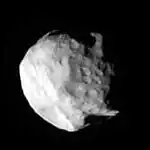 | Saturn | XII (12) | 17.6±0.4 | 377,420 | 2.737 | 1980 | 1980 | Laques, Lecacheux | Main-group trojan | [13][14] |
| Telesto | Saturn | XIII (13) | 12.4±0.4 | 294,710 | 1.888 | 1980 | 1980 | Smith, Reitsema, Larson, Fountain (Voyager 1) | Main-group trojan | [13][14] | |
| Calypso | Saturn | XIV (14) | 10.7±0.7 | 294,710 | 1.888 | 1980 | 1980 | Pascu, Seidelmann, Baum, Currie | Main-group trojan | [13][14] | |
| Atlas | Saturn | XV (15) | 15.1±0.9 | 137,670 | 0.602 | 1980 | 1980 | Terrile (Voyager 1) | Inner moon (shepherd) | [13][14] | |
| Prometheus |  | Saturn | XVI (16) | 43.1±2.7 | 139,380 | 0.613 | 1980 | 1980 | Collins (Voyager 1) | Inner moon (shepherd) | [13][14] |
| Pandora | Saturn | XVII (17) | 40.7±1.5 | 141,720 | 0.629 | 1980 | 1980 | Collins (Voyager 1) | Inner moon (shepherd) | [13][14] | |
| Pan | Saturn | XVIII (18) | 14.1 | 133,580 | 0.575 | 1981 | 1990 | Showalter (Voyager 2) | Inner moon (shepherd) | [13][14] | |
| Ymir | Saturn | XIX (19) | 9 | 23,140,400 | 1,315.58 (r) | 2000 | 2000 | Gladman | Retrograde irregular (Norse) | [13][14] | |
| Paaliaq | Saturn | XX (20) | 11 | 15,200,000 | 686.95 | 2000 | 2000 | Gladman | Prograde irregular (Inuit) | [13][14] | |
| Tarvos | Saturn | XXI (21) | 7.5 | 17,983,000 | 926.23 | 2000 | 2000 | Gladman, Kavelaars | Prograde irregular (Gallic) | [13][14] | |
| Ijiraq | Saturn | XXII (22) | 6 | 11,124,000 | 451.42 | 2000 | 2000 | Gladman, Kavelaars | Prograde irregular (Inuit) | [13][14] | |
| Suttungr | Saturn | XXIII (23) | 3.5 | 19,459,000 | 1,016.67 (r) | 2000 | 2000 | Gladman, Kavelaars | Retrograde irregular (Norse) | [13][14] | |
| Kiviuq | Saturn | XXIV (24) | 8 | 11,110,000 | 449.22 | 2000 | 2000 | Gladman | Prograde irregular (Inuit) | [13][14] | |
| Mundilfari | Saturn | XXV (25) | 3.5 | 18,628,000 | 952.77 (r) | 2000 | 2000 | Gladman, Kavelaars | Retrograde irregular (Norse) | [13][14] | |
| Albiorix | 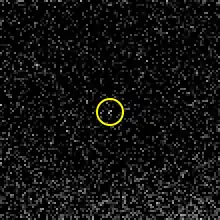 | Saturn | XXVI (26) | 16 | 16,182,000 | 783.45 | 2000 | 2000 | Holman, Spahr | Prograde irregular (Gallic) | [13][14] |
| Skathi | Saturn | XXVII (27) | 4 | 15,540,000 | 728.20 (r) | 2000 | 2000 | Gladman, Kavelaars | Retrograde irregular (Norse) | [13][14] | |
| Erriapus | Saturn | XXVIII (28) | 5 | 17,343,000 | 871.19 | 2000 | 2000 | Gladman, Kavelaars | Prograde irregular (Gallic) | [13][14] | |
| Siarnaq | Saturn | XXIX (29) | 20 | 18,015,400 | 896.44 | 2000 | 2000 | Gladman, Kavelaars | Prograde irregular (Inuit) | [13][14] | |
| Thrymr | Saturn | XXX (30) | 3.5 | 20,314,000 | 1,094.11 (r) | 2000 | 2000 | Gladman, Kavelaars | Retrograde irregular (Norse) | [13][14] | |
| Narvi | Saturn | XXXI (31) | 3.5 | 19,007,000 | 1,003.86 (r) | 2003 | 2003 | Sheppard, Jewitt, Kleyna | Retrograde irregular (Norse) | [13][14] | |
| Methone | Saturn | XXXII (32) | 1.45 | 194,440 | 1.010 | 2004 | 2004 | Porco, Charnoz, Brahic, Dones (Cassini–Huygens) | Alkyonide moon | [14] | |
| Pallene |  | Saturn | XXXIII (33) | 2.22 | 212,280 | 1.154 | 2004 | 2004 | Gordon, Murray, Beurle, et al. (Cassini–Huygens) | Alkyonide moon | [14] |
| Polydeuces | Saturn | XXXIV (34) | 1.3 | 377,200 | 2.737 | 2004 | 2004 | Porco et al. (Cassini–Huygens) | Main-group trojan | [14] | |
| Daphnis | Saturn | XXXV (35) | 3.8±0.8 | 136,500 | 0.594 | 2005 | 2005 | Porco et al. (Cassini–Huygens) | Inner moon (shepherd) | [14] | |
| Aegir | Saturn | XXXVI (36) | 3 | 20,751,000 | 1,117.52 (r) | 2004 | 2005 | Sheppard, Jewitt, Kleyna, Marsden | Retrograde irregular (Norse) | [13][14] | |
| Bebhionn | Saturn | XXXVII (37) | 3 | 17,119,000 | 834.84 | 2004 | 2005 | Sheppard, Jewitt, Kleyna, Marsden | Prograde irregular (Gallic) | [13][14] | |
| Bergelmir | Saturn | XXXVIII (38) | 3 | 19,336,000 | 1,005.74 (r) | 2004 | 2005 | Sheppard, Jewitt, Kleyna, Marsden | Retrograde irregular (Norse) | [13][14] | |
| Bestla | Saturn | XXXIX (39) | 3.5 | 20,192,000 | 1,088.72 (r) | 2004 | 2005 | Sheppard, Jewitt, Kleyna, Marsden | Retrograde irregular (Norse) | [13][14] | |
| Farbauti | Saturn | XL (40) | 2.5 | 20,377,000 | 1,085.55 (r) | 2004 | 2005 | Sheppard, Jewitt, Kleyna, Marsden | Retrograde irregular (Norse) | [13][14] | |
| Fenrir | Saturn | XLI (41) | 2 | 22,454,000 | 1,260.35 (r) | 2004 | 2005 | Sheppard, Jewitt, Kleyna, Marsden | Retrograde irregular (Norse) | [13][14] | |
| Fornjot | Saturn | XLII (42) | 3 | 25,146,000 | 1,494.2 (r) | 2004 | 2005 | Sheppard, Jewitt, Kleyna, Marsden | Retrograde irregular (Norse) | [13][14] | |
| Hati | Saturn | XLIII (43) | 3 | 19,846,000 | 1,038.61 (r) | 2004 | 2005 | Sheppard, Jewitt, Kleyna, Marsden | Retrograde irregular (Norse) | [13][14] | |
| Hyrrokkin | Saturn | XLIV (44) | 4 | 18,437,000 | 931.86 (r) | 2004 | 2006 | Sheppard, Jewitt, Kleyna | Retrograde irregular (Norse) | [14] | |
| Kari | Saturn | XLV (45) | 3.5 | 22,089,000 | 1,230.97 (r) | 2006 | 2006 | Sheppard, Jewitt, Kleyna | Retrograde irregular (Norse) | [14] | |
| Loge | Saturn | XLVI (46) | 3 | 23,058,000 | 1,311.36 (r) | 2006 | 2006 | Sheppard, Jewitt, Kleyna | Retrograde irregular (Norse) | [14] | |
| Skoll | Saturn | XLVII (47) | 3 | 17,665,000 | 878.29 (r) | 2006 | 2006 | Sheppard, Jewitt, Kleyna | Retrograde irregular (Norse) | [14] | |
| Surtur | Saturn | XLVIII (48) | 3 | 22,704,000 | 1,297.36 (r) | 2006 | 2006 | Sheppard, Jewitt, Kleyna | Retrograde irregular (Norse) | [14] | |
| Anthe |  | Saturn | XLIX (49) | 0.9 | 197,700 | 1.0365 | 2007 | 2007 | Porco et al. (Cassini–Huygens) | Alkyonide moon | [52] |
| Jarnsaxa | Saturn | L (50) | 3 | 18,811,000 | 964.74 (r) | 2006 | 2006 | Sheppard, Jewitt, Kleyna | Retrograde irregular (Norse) | [14] | |
| Greip | Saturn | LI (51) | 3 | 18,206,000 | 921.19 (r) | 2006 | 2006 | Sheppard, Jewitt, Kleyna | Retrograde irregular (Norse) | [14] | |
| Tarqeq | Saturn | LII (52) | 3.5 | 18,009,000 | 887.48 | 2007 | 2007 | Sheppard, Jewitt, Kleyna | Prograde irregular (Inuit) | [14] | |
| Aegaeon | Saturn | LIII (53) | 0.33 | 167,500 | 0.808 | 2008 | 2009 | Cassini Imaging Science Team Cassini–Huygens | G-ring moonlet | [53][54] | |
| Gridr | Saturn | LIV (54) | 3 | 19,418,000 | 1,010.55 (r) | 2004 | 2019 | Sheppard, Jewitt, Kleyna | Retrograde irregular (Norse) | [55] | |
| Angrboda | Saturn | LV (55) | 3 | 20,636,000 | 1,107.13 (r) | 2004 | 2019 | Sheppard, Jewitt, Kleyna | Retrograde irregular (Norse) | [56] | |
| Skrymir | Saturn | LVI (56) | 4 | 21,163,000 | 1,149.82 (r) | 2004 | 2019 | Sheppard, Jewitt, Kleyna | Retrograde irregular (Norse) | [57] | |
| Gerd | Saturn | LVII (57) | 4 | 21,174,000 | 1,150.69 (r) | 2004 | 2019 | Sheppard, Jewitt, Kleyna | Retrograde irregular (Norse) | [58] | |
| S/2004 S 26 | Saturn | LVIII (58) | 4 | 26,676,000 | 1,627.18 (r) | 2004 | 2019 | Sheppard, Jewitt, Kleyna, Marsden | Retrograde irregular (Norse) | [59] | |
| Eggther | Saturn | LIX (59) | 6 | 19,976,000 | 1,054.45 (r) | 2004 | 2019 | Sheppard, Jewitt, Kleyna, Marsden, Jacobson | Retrograde irregular (Norse) | [60] | |
| S/2004 S 29 | Saturn | LX (60) | 4 | 16,981,000 | 826.44 | 2004 | 2019 | Sheppard, Jewitt, Kleyna, Marsden | Prograde irregular (Gallic) | [61] | |
| Beli | Saturn | LXI (61) | 3 | 20,396,000 | 1,087.84 (r) | 2004 | 2019 | Sheppard, Jewitt, Kleyna | Retrograde irregular (Norse) | [62] | |
| Gunnlod | Saturn | LXII (62) | 4 | 21,214,000 | 1,153.96 (r) | 2004 | 2019 | Sheppard, Jewitt, Kleyna | Retrograde irregular (Norse) | [63] | |
| Thiazzi | Saturn | LXIII (63) | 4 | 24,168,000 | 1,403.18 (r) | 2004 | 2019 | Sheppard, Jewitt, Kleyna | Retrograde irregular (Norse) | [64] | |
| S/2004 S 34 | Saturn | LXIV (64) | 3 | 24,299,000 | 1,414.59 (r) | 2004 | 2019 | Sheppard, Jewitt, Kleyna | Retrograde irregular (Norse) | [65] | |
| Alvaldi | Saturn | LXV (65) | 6 | 22,412,000 | 1,253.08 (r) | 2004 | 2019 | Sheppard, Jewitt, Kleyna, Marsden | Retrograde irregular (Norse) | [66] | |
| Geirrod | Saturn | LXVI (66) | 4 | 21,908,000 | 1,211.02 (r) | 2004 | 2019 | Sheppard, Jewitt, Kleyna | Retrograde irregular (Norse) | [67] | |
| S/2004 S 7 | Saturn | — | 3 | 20,999,000 | 1,140.24 (r) | 2004 | 2005 | Sheppard, Jewitt, Kleyna, Marsden | Retrograde irregular (Norse?) | [13][14] | |
| S/2004 S 12 | Saturn | — | 2.5 | 19,878,000 | 1,046.19 (r) | 2004 | 2005 | Sheppard, Jewitt, Kleyna, Marsden | Retrograde irregular (Norse) | [13][14] | |
| S/2004 S 13 | Saturn | — | 3 | 18,404,000 | 933.48 (r) | 2004 | 2005 | Sheppard, Jewitt, Kleyna, Marsden | Retrograde irregular (Norse?) | [13][14] | |
| S/2004 S 17 | Saturn | — | 2 | 19,447,000 | 1,014.70 (r) | 2004 | 2005 | Sheppard, Jewitt, Kleyna, Marsden | Retrograde irregular (Norse?) | [13][14] | |
| S/2004 S 21 | Saturn | — | 3 | 22,645,000 | 1,272.61 (r) | 2004 | 2019 | Sheppard, Jewitt, Kleyna | Retrograde irregular (Norse) | [68] | |
| S/2004 S 24 | Saturn | — | 3 | 22,901,000 | 1,294.25 | 2004 | 2019 | Sheppard, Jewitt, Kleyna, Marsden | Prograde irregular (group unknown, possibly Gallic) | [69] | |
| S/2004 S 28 | Saturn | — | 4 | 22,020,000 | 1,220.31 (r) | 2004 | 2019 | Sheppard, Jewitt, Kleyna, Marsden | Retrograde irregular (Norse?) | [70] | |
| S/2004 S 31 | Saturn | — | 4 | 17,568,000 | 869.65 | 2004 | 2019 | Sheppard, Jewitt, Kleyna, Marsden | Prograde irregular (Inuit) | [71] | |
| S/2004 S 36 | Saturn | — | 3 | 23,192,000 | 1,319.07 (r) | 2004 | 2019 | Sheppard, Jewitt, Kleyna | Retrograde irregular (Norse) | [72] | |
| S/2004 S 37 | Saturn | — | 4 | 15,892,000 | 748.18 (r) | 2004 | 2019 | Sheppard, Jewitt, Kleyna | Retrograde irregular (Norse) | [73] | |
| S/2004 S 39 | Saturn | — | 3 | 23,575,000 | 1,351.83 (r) | 2004 | 2019 | Sheppard, Jewitt, Kleyna | Retrograde irregular (Norse) | [74] | |
| S/2004 S 40 | Saturn | — | 2 | 16,075,600 | 765.92 (r) | 2004 | 2023 | Sheppard et al. | Retrograde irregular (Norse) | [75] | |
| S/2004 S 41 | Saturn | — | 2 | 18,095,000 | 895.76 (r) | 2004 | 2023 | Sheppard et al. | Retrograde irregular (Norse) | [76] | |
| S/2004 S 42 | Saturn | — | 2 | 18,240,800 | 910.61 (r) | 2004 | 2023 | Sheppard et al. | Retrograde irregular (Norse) | [77] | |
| S/2004 S 43 | Saturn | — | 2 | 18,935,000 | 971.48 (r) | 2004 | 2023 | Sheppard et al. | Retrograde irregular (Norse) | [78] | |
| S/2004 S 44 | Saturn | — | 2.5 | 19,515,400 | 1,014.98 (r) | 2004 | 2023 | Sheppard et al. | Retrograde irregular (Norse) | [79] | |
| S/2004 S 45 | Saturn | — | 2 | 19,693,600 | 1,058.95 (r) | 2004 | 2023 | Sheppard et al. | Retrograde irregular (Norse) | [80] | |
| S/2004 S 46 | Saturn | — | 1.5 | 20,513,000 | 1,107.57 (r) | 2004 | 2023 | Sheppard et al. | Retrograde irregular (Norse) | [81] | |
| S/2004 S 47 | Saturn | — | 2 | 16,050,600 | 755.69 (r) | 2004 | 2023 | Sheppard et al. | Retrograde irregular (Norse) | [82] | |
| S/2004 S 48 | Saturn | — | 2 | 22,136,700 | 1,248.52 (r) | 2004 | 2023 | Sheppard et al. | Retrograde irregular (Norse) | [83] | |
| S/2004 S 49 | Saturn | — | 2 | 22,399,700 | 1,290.34 (r) | 2004 | 2023 | Sheppard et al. | Retrograde irregular (Norse) | [84] | |
| S/2004 S 50 | Saturn | — | 1.5 | 22,346,000 | 1,219.11 (r) | 2004 | 2023 | Sheppard et al. | Retrograde irregular (Norse) | [85] | |
| S/2004 S 51 | Saturn | — | 2 | 25,208,200 | 1,544.65 (r) | 2004 | 2023 | Sheppard et al. | Retrograde irregular (Norse) | [86] | |
| S/2004 S 52 | Saturn | — | 1.5 | 26,448,100 | 1,573.49 (r) | 2004 | 2023 | Sheppard et al. | Retrograde irregular (Norse) | [87] | |
| S/2004 S 53 | Saturn | — | 2 | 23,279,800 | 1,367.72 (r) | 2004 | 2023 | Sheppard et al. | Retrograde irregular (Norse) | [88] | |
| S/2005 S 4 | Saturn | — | 2.5 | 11,324,500 | 448.63 | 2005 | 2023 | Sheppard et al. | Prograde irregular (Inuit) | [89] | |
| S/2005 S 5 | Saturn | — | 1.5 | 21,366,200 | 1,138.62 (r) | 2005 | 2023 | Sheppard et al. | Retrograde irregular (Norse) | [90] | |
| S/2006 S 1 | Saturn | — | 3 | 18,790,000 | 963.37 (r) | 2006 | 2006 | Sheppard, Jewitt, Kleyna | Retrograde irregular (Norse) | [14] | |
| S/2006 S 3 | Saturn | — | 3 | 22,096,000 | 1,227.21 (r) | 2006 | 2006 | Sheppard, Jewitt, Kleyna | Retrograde irregular (Norse) | [14] | |
| S/2006 S 9 | Saturn | — | 1.5 | 14,406,600 | 648.71 (r) | 2006 | 2023 | Sheppard et al. | Retrograde irregular (Norse) | [91] | |
| S/2006 S 10 | Saturn | — | 1.5 | 18,979,900 | 965.26 (r) | 2006 | 2023 | Sheppard et al. | Retrograde irregular (Norse) | [92] | |
| S/2006 S 11 | Saturn | — | 1.5 | 19,711,900 | 1,018.45 (r) | 2006 | 2023 | Sheppard et al. | Retrograde irregular (Norse) | [93] | |
| S/2006 S 12 | Saturn | — | 2 | 19,569,800 | 1,043.16 | 2006 | 2023 | Sheppard et al. | Prograde irregular (group unknown, possibly Gallic) | [94] | |
| S/2006 S 13 | Saturn | — | 2 | 19,953,800 | 1,061.74 (r) | 2006 | 2023 | Sheppard et al. | Retrograde irregular (Norse) | [95] | |
| S/2006 S 14 | Saturn | — | 1.5 | 21,062,100 | 1,150.64 (r) | 2006 | 2023 | Sheppard et al. | Retrograde irregular (Norse) | [96] | |
| S/2006 S 15 | Saturn | — | 2 | 21,799,400 | 1,183.57 (r) | 2006 | 2023 | Sheppard et al. | Retrograde irregular (Norse) | [97] | |
| S/2006 S 16 | Saturn | — | 1.5 | 21,720,700 | 1,217.36 (r) | 2006 | 2023 | Sheppard et al. | Retrograde irregular (Norse) | [98] | |
| S/2006 S 17 | Saturn | — | 2 | 22,384,900 | 1,262.48 (r) | 2006 | 2023 | Sheppard et al. | Retrograde irregular (Norse) | [99] | |
| S/2006 S 18 | Saturn | — | 2 | 22,760,700 | 1,324.09 (r) | 2006 | 2023 | Sheppard et al. | Retrograde irregular (Norse) | [100] | |
| S/2006 S 19 | Saturn | — | 2 | 23,801,100 | 1,324.68 (r) | 2006 | 2023 | Sheppard et al. | Retrograde irregular (Norse) | [101] | |
| S/2006 S 20 | Saturn | — | 2.5 | 13,193,800 | 563.89 (r) | 2006 | 2023 | Sheppard et al. | Retrograde irregular (Norse) | [102] | |
| S/2007 S 2 | Saturn | — | 3 | 16,725,000 | 808.08 (r) | 2007 | 2007 | Sheppard, Jewitt, Kleyna | Retrograde irregular (Norse) | [14] | |
| S/2007 S 3 | Saturn | — | 3 | 18,975,000 | 977.8 (r) | 2007 | 2007 | Sheppard, Jewitt, Kleyna | Retrograde irregular (Norse?) | [14] | |
| S/2007 S 5 | Saturn | — | 2 | 15,835,700 | 748.50 (r) | 2007 | 2023 | Sheppard et al. | Retrograde irregular (Norse) | [103] | |
| S/2007 S 6 | Saturn | — | 1.5 | 18,544,900 | 944.31 (r) | 2007 | 2023 | Sheppard et al. | Retrograde irregular (Norse) | [104] | |
| S/2007 S 7 | Saturn | — | 2 | 15,931,700 | 742.79 (r) | 2007 | 2023 | Sheppard et al. | Retrograde irregular (Norse) | [105] | |
| S/2007 S 8 | Saturn | — | 2 | 17,049,000 | 826.94 | 2007 | 2023 | Sheppard et al. | Prograde irregular (Gallic) | [106] | |
| S/2007 S 9 | Saturn | — | 2 | 20,174,600 | 1,099.69 (r) | 2007 | 2023 | Sheppard et al. | Retrograde irregular (Norse) | [107] | |
| S/2009 S 1 | Saturn | — | 0.15 | 117,000 | 0.471 | 2009 | 2009 | Cassini Imaging Science Team Cassini–Huygens | B-ring moonlet | [108] | |
| S/2019 S 1 | Saturn | — | 3 | 11,221,000 | 443.8 | 2019 | 2021 | Ashton, Gladman, Petit, Alexandersen | Prograde irregular (Inuit) | [109] | |
| S/2019 S 2 | Saturn | — | 1.5 | 16,559,900 | 796.22 (r) | 2019 | 2023 | Ashton et al. | Retrograde irregular (Norse) | [110] | |
| S/2019 S 3 | Saturn | — | 2 | 17,077,200 | 836.68 (r) | 2019 | 2023 | Ashton et al. | Retrograde irregular (Norse) | [111] | |
| S/2019 S 4 | Saturn | — | 1.5 | 17,956,700 | 898.40 (r) | 2019 | 2023 | Ashton et al. | Retrograde irregular (Norse) | [112] | |
| S/2019 S 5 | Saturn | — | 1.5 | 19,076,900 | 971.54 (r) | 2019 | 2023 | Ashton et al. | Retrograde irregular (Norse) | [113] | |
| S/2019 S 6 | Saturn | — | 2 | 18,198,700 | 905.41 | 2019 | 2023 | Ashton et al. | Prograde irregular (Inuit) | [114] | |
| S/2019 S 7 | Saturn | — | 2 | 20,181,300 | 1,093.86 (r) | 2019 | 2023 | Ashton et al. | Retrograde irregular (Norse) | [115] | |
| S/2019 S 8 | Saturn | — | 2 | 20,284,400 | 1,080.60 (r) | 2019 | 2023 | Ashton et al. | Retrograde irregular (Norse) | [116] | |
| S/2019 S 9 | Saturn | — | 2 | 20,359,000 | 1,104.27 (r) | 2019 | 2023 | Ashton et al. | Retrograde irregular (Norse) | [117] | |
| S/2019 S 10 | Saturn | — | 1.5 | 20,713,400 | 1,129.53 (r) | 2019 | 2023 | Ashton et al. | Retrograde irregular (Norse) | [118] | |
| S/2019 S 11 | Saturn | — | 2 | 20,663,700 | 1,097.33 (r) | 2019 | 2023 | Ashton et al. | Retrograde irregular (Norse) | [119] | |
| S/2019 S 12 | Saturn | — | 2 | 20,904,500 | 1,130.40 (r) | 2019 | 2023 | Ashton et al. | Retrograde irregular (Norse) | [120] | |
| S/2019 S 13 | Saturn | — | 1.5 | 20,965,800 | 1,132.90 (r) | 2019 | 2023 | Ashton et al. | Retrograde irregular (Norse) | [121] | |
| S/2019 S 14 | Saturn | — | 2 | 17,853,000 | 902.00 | 2019 | 2023 | Ashton et al. | Prograde irregular (Inuit) | [122] | |
| S/2019 S 15 | Saturn | — | 1.5 | 21,189,700 | 1,156.21 (r) | 2019 | 2023 | Ashton et al. | Retrograde irregular (Norse) | [123] | |
| S/2019 S 16 | Saturn | — | 1.5 | 23,266,700 | 1,360.26 (r) | 2019 | 2023 | Ashton et al. | Retrograde irregular (Norse) | [124] | |
| S/2019 S 17 | Saturn | — | 2 | 22,724,100 | 1,322.15 (r) | 2019 | 2023 | Ashton et al. | Retrograde irregular (Norse) | [125] | |
| S/2019 S 18 | Saturn | — | 1.5 | 23,140,700 | 1,349.74 (r) | 2019 | 2023 | Ashton et al. | Retrograde irregular (Norse) | [126] | |
| S/2019 S 19 | Saturn | — | 1.5 | 23,047,200 | 1,342.57 (r) | 2019 | 2023 | Ashton et al. | Retrograde irregular (Norse) | [127] | |
| S/2019 S 20 | Saturn | — | 1.5 | 23,678,600 | 1,343.58 (r) | 2019 | 2023 | Ashton et al. | Retrograde irregular (Norse) | [128] | |
| S/2019 S 21 | Saturn | — | 2 | 26,439,000 | 1,572.06 (r) | 2019 | 2023 | Ashton et al. | Retrograde irregular (Norse) | [129] | |
| S/2020 S 1 | Saturn | — | 2 | 11,338,700 | 450.83 | 2020 | 2023 | Ashton et al. | Prograde irregular (Inuit) | [130] | |
| S/2020 S 2 | Saturn | — | 1.5 | 17,869,300 | 907.00 (r) | 2020 | 2023 | Ashton et al. | Retrograde irregular (Norse) | [131] | |
| S/2020 S 3 | Saturn | — | 1.5 | 18,054,700 | 896.35 | 2020 | 2023 | Ashton et al. | Prograde irregular (Inuit) | [132] | |
| S/2020 S 4 | Saturn | — | 1.5 | 18,235,500 | 910.34 | 2020 | 2023 | Ashton et al. | Prograde irregular (Gallic) | [133] | |
| S/2020 S 5 | Saturn | — | 1.5 | 18,391,300 | 933.52 | 2020 | 2023 | Ashton et al. | Prograde irregular (Inuit) | [134] | |
| S/2020 S 6 | Saturn | — | 1.5 | 21,265,300 | 1,149.11 (r) | 2020 | 2023 | Ashton et al. | Retrograde irregular (Norse) | [135] | |
| S/2020 S 7 | Saturn | — | 1.5 | 17,400,000 | 844.85 (r) | 2020 | 2023 | Ashton et al. | Retrograde irregular (Norse) | [136] | |
| S/2020 S 8 | Saturn | — | 1.5 | 21,966,700 | 1,201.72 (r) | 2020 | 2023 | Ashton et al. | Retrograde irregular (Norse) | [137] | |
| S/2020 S 9 | Saturn | — | 2 | 25,434,100 | 1,565.23 (r) | 2020 | 2023 | Ashton et al. | Retrograde irregular (Norse) | [138] | |
| S/2020 S 10 | Saturn | — | 1.5 | 25,314,800 | 1,479.87 (r) | 2020 | 2023 | Ashton et al. | Retrograde irregular (Norse) | [139] | |
| Ariel | .jpg.webp) | Uranus | I (1) | 578.9±0.6 | 190,900 | 2.520 | 1851 | 1851 | Lassell | Main-group moon | [13][14] |
| Umbriel |  | Uranus | II (2) | 584.7±2.8 | 266,000 | 4.144 | 1851 | 1851 | Lassell | Main-group moon | [13][14] |
| Titania | _color%252C_cropped.jpg.webp) | Uranus | III (3) | 788.9±1.8 | 436,300 | 8.706 | 1787 | 1787 | Herschel | Main-group moon | [13][14] |
| Oberon | 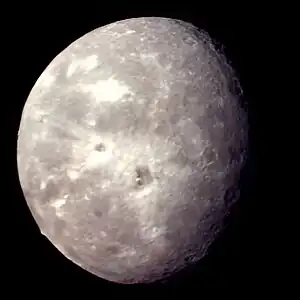 | Uranus | IV (4) | 761.4±2.6 | 583,500 | 13.46 | 1787 | 1787 | Herschel | Main-group moon | [13][14] |
| Miranda | 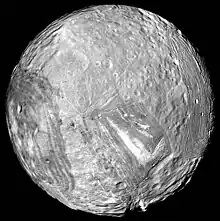 | Uranus | V (5) | 235.8±0.7 | 129,900 | 1.413 | 1948 | 1949 | Kuiper | Main-group moon | [13][14] |
| Cordelia | Uranus | VI (6) | 20.1±3 | 49,800 | 0.335 | 1986 | 1986 | Terrile (Voyager 2) | Inner moon (shepherd) | [13][14] | |
| Ophelia | 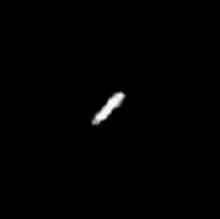 | Uranus | VII (7) | 21.4±4 | 53,800 | 0.376 | 1986 | 1986 | Terrile (Voyager 2) | Inner moon (shepherd) | [13][14] |
| Bianca |  | Uranus | VIII (8) | 25.7±2 | 59,200 | 0.435 | 1986 | 1986 | Smith (Voyager 2) | Inner moon | [13][14] |
| Cressida | Uranus | IX (9) | 39.8±2 | 61,800 | 0.464 | 1986 | 1986 | Synnott (Voyager 2) | Inner moon | [13][14] | |
| Desdemona | Uranus | X (10) | 32±4 | 62,700 | 0.474 | 1986 | 1986 | Synnott (Voyager 2) | Inner moon | [13][14] | |
| Juliet | 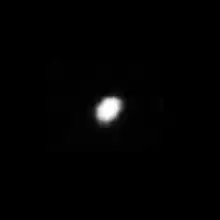 | Uranus | XI (11) | 46.8±4 | 64,400 | 0.493 | 1986 | 1986 | Synnott (Voyager 2) | Inner moon | [13][14] |
| Portia | 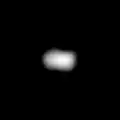 | Uranus | XII (12) | 67.6±4.0 | 66,100 | 0.513 | 1986 | 1986 | Synnott (Voyager 2) | Inner moon | [13][14] |
| Rosalind | Uranus | XIII (13) | 36±6 | 69,900 | 0.558 | 1986 | 1986 | Synnott (Voyager 2) | Inner moon | [13][14] | |
| Belinda | 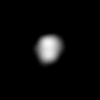 | Uranus | XIV (14) | 40.3±8 | 75,300 | 0.624 | 1986 | 1986 | Synnott (Voyager 2) | Inner moon | [13][14] |
| Puck |  | Uranus | XV (15) | 81±2 | 86,000 | 0.762 | 1985 | 1986 | Synnott (Voyager 2) | Inner moon | [13][14] |
| Caliban | 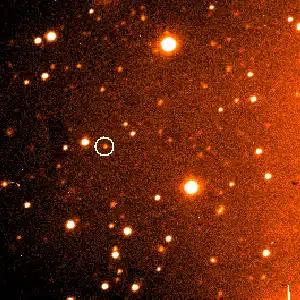 | Uranus | XVI (16) | 36.4 | 7,231,100 | 579.73 (r) | 1997 | 1997 | Gladman, Nicholson, Burns, Kavelaars | Retrograde irregular | [140][14] |
| Sycorax | Uranus | XVII (17) | 93 | 12,179,400 | 1,288.38 (r) | 1997 | 1997 | Gladman, Nicholson, Burns, Kavelaars | Retrograde irregular | [140][14] | |
| Prospero |  | Uranus | XVIII (18) | 25 | 16,256,000 | 1,978.29 (r) | 1999 | 1999 | Gladman, Holman, Kavelaars, Petit, Scholl | Retrograde irregular | [13][14] |
| Setebos | 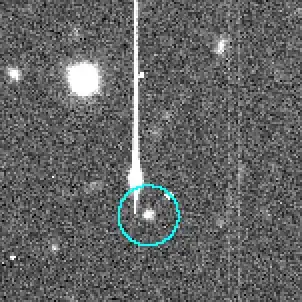 | Uranus | XIX (19) | 24 | 17,418,000 | 2,225.21 (r) | 1999 | 1999 | Gladman, Holman, Kavelaars, Petit, Scholl | Retrograde irregular | [13][14] |
| Stephano |  | Uranus | XX (20) | 16 | 8,004,000 | 677.36 (r) | 1999 | 1999 | Gladman, Holman, Kavelaars, Petit, Scholl | Retrograde irregular | [13][14] |
| Trinculo | Uranus | XXI (21) | 9.5 | 8,504,000 | 749.24 (r) | 2001 | 2002 | Holman, Kavelaars, Milisavljevic | Retrograde irregular | [13][14] | |
| Francisco | Uranus | XXII (22) | 11 | 4,276,000 | 266.56 (r) | 2001 | 2003 | Holman, Kavelaars, Milisavljevic, Gladman | Retrograde irregular | [13][14] | |
| Margaret | 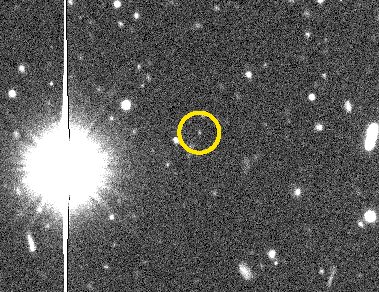 | Uranus | XXIII (23) | 10 | 14,345,000 | 1,687.01 | 2003 | 2003 | Sheppard, Jewitt | Prograde irregular | [13][14] |
| Ferdinand | 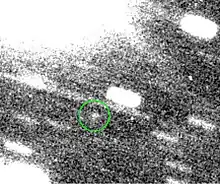 | Uranus | XXIV (24) | 10 | 20,901,000 | 2,887.21 (r) | 2001 | 2003 | Holman, Kavelaars, Milisavljevic, et al. | Retrograde irregular | [13][14] |
| Perdita | Uranus | XXV (25) | 15 | 76,417 | 0.638 | 1986 | 1999/2003 | Karkoschka (Voyager 2) | Inner moon | [14] | |
| Mab | Uranus | XXVI (26) | 12 | 97,736 | 0.923 | 2003 | 2003 | Showalter, Lissauer | Inner moon | [14] | |
| Cupid | Uranus | XXVII (27) | 9 | 74,392 | 0.613 | 2003 | 2003 | Showalter, Lissauer | Inner moon | [14] | |
| Triton |  | Neptune | I (1) | 1,353.4±0.9 | 354,800 | 5.877 (r) | 1846 | 1846 | Lassell | Retrograde irregular | [13][14] |
| Nereid | 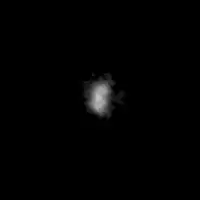 | Neptune | II (2) | 170±25 | 5,513,820 | 360.14 | 1949 | 1949 | Kuiper | Prograde irregular | [141][14] |
| Naiad | Neptune | III (3) | 33±3 | 48,224 | 0.294 | 1989 | 1989 | Terrile (Voyager 2) | Inner moon | [13][14] | |
| Thalassa | Neptune | IV (4) | 41±3 | 50,075 | 0.311 | 1989 | 1989 | Terrile (Voyager 2) | Inner moon | [13][14] | |
| Despina | Neptune | V (5) | 78±4.7 | 52,526 | 0.335 | 1989 | 1989 | Synnott (Voyager 2) | Inner moon | [13][14] | |
| Galatea |  | Neptune | VI (6) | 88±4 | 61,953 | 0.429 | 1989 | 1989 | Synnott (Voyager 2) | Inner moon | [13][14] |
| Larissa | Neptune | VII (7) | 97±3 | 73,548 | 0.555 | 1981/1989 | 1981/1989 | Reitsema, Hubbard, Lebofsky, Tholen (Voyager 2) | Inner moon | [13][14] | |
| Proteus | .jpg.webp) | Neptune | VIII (8) | 210±7 | 117,647 | 1.122 | 1989 | 1989 | Synnott (Voyager 2) | Inner moon | [13][14] |
| Halimede | Neptune | IX (9) | 31 | 15,728,000 | 1,879.71 (r) | 2002 | 2003 | Holman, Kavelaars, Grav, Fraser, Milisavljevic | Retrograde irregular | [13][14] | |
| Psamathe | Neptune | X (10) | 20 | 46,695,000 | 9,115.91 (r) | 2003 | 2003 | Jewitt, Kleyna, Sheppard, Holman, Kavelaars | Retrograde irregular | [13][14] | |
| Sao | Neptune | XI (11) | 22 | 22,422,000 | 2,914.07 | 2002 | 2003 | Holman, Kavelaars, Grav, Fraser, Milisavljevic | Prograde irregular | [13][14] | |
| Laomedeia | Neptune | XII (12) | 21 | 23,571,000 | 3,167.85 | 2002 | 2003 | Holman, Kavelaars, Grav, Fraser, Milisavljevic | Prograde irregular | [13][14] | |
| Neso | Neptune | XIII (13) | 30 | 48,387,000 | 9,740.73 (r) | 2002 | 2003 | Holman, Kavelaars, Grav, Fraser, Milisavljevic | Retrograde irregular | [13][14] | |
| Hippocamp | Neptune | XIV (14) | 17.4 | 105,283 | 0.9362 | 2004/2013 | 2013 | Showalter et al. | Inner moon | [142] | |
| Vanth |  | Orcus | I (1) | 221±5 | 9,000±9 | 9.539 | 2005 | 2007 | Brown & Suer | Synchronous rotation (Binary) | [143] |
| S/2005 (208996) 1 |  | (208996) 2003 AZ84 | — | 72±12 | 7,200±300 | ≈12 | 2005 | 2007 | Brown & Suer | unrecovered natural satellite | [144] |
| Charon | 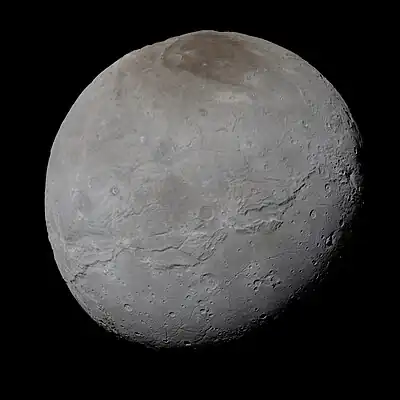 | Pluto | I (1) | 606±0.5 | 19,591 | 6.387 | 1978 | 1978 | Christy | Synchronous rotation (Binary) | [13][14] |
| Nix | Pluto | II (2) | 22.5 | 48,671 | 24.85 | 2005 | 2005 | Weaver, Stern, Buie, et al. | Chaotic rotation | [13][14] | |
| Hydra | Pluto | III (3) | 27.5 | 64,698 | 38.20 | 2005 | 2005 | Weaver, Stern, Buie, et al. | Chaotic rotation | [13][14] | |
| Kerberos | .jpg.webp) | Pluto | IV (4) | 7 | 57,729 | 32.17 | 2011 | 2011 | Showalter (Hubble) | Chaotic rotation | [13][14][145][146] |
| Styx | .jpg.webp) | Pluto | V (5) | 5.5 | 42,393 | 20.16 | 2012 | 2012 | Showalter (Hubble) | Chaotic rotation | [13][14][147] |
| Actaea |  | Salacia | I (1) | 142±5 | 5,724±27 | 5.494 | 2006 | 2006 | Noll et al. | Binary system | [143] |
| Hiʻiaka | 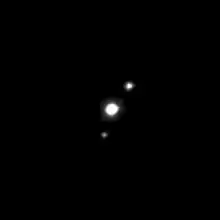 | Haumea | I (1) | ≈160 | 49,880 | 49.12 | 2005 | 2005 | Brown et al. | assuming a chaotic rotation | [8][148][149] |
| Namaka | Haumea | II (2) | ≈85 | 25,657 | 18.2783 | 2005 | 2005 | Brown et al. | assuming a chaotic rotation | [8][148][149] | |
| Weywot | 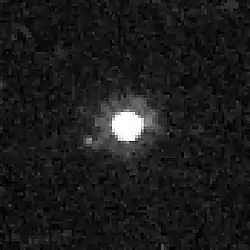 | Quaoar | I (1) | 40.5±5.5[150] | 14,500±800 | 12.438 | 2006 | 2007 | Brown | Binary system | [150][151] |
| S/2015 (136472) 1 | .jpg.webp) | Makemake | — | ≈87.5 | >21,000 | >12.4 | 2015 | 2016 | Parker et al. | [152][153] | |
| Ilmarë |  | Varda | I (1) | 163±18[154] | 4,809±39 | 5.751 | 2009 | 2011 | Noll et al. | Binary system | [155] |
| S/2018 (532037) 1 | (532037) 2013 FY27 | — | ≈95[156] | >9,800 ± 40 | ≈19 | 2018 | 2018 | Sheppard | likely a prograde orbit | [157] | |
| Xiangliu | .png.webp) | Gonggong | I (1) | <100[158] | 24,020±200 | 25.221 | 2010 | 2016 | Marton, Kiss & Müller | assuming a prograde orbit | [158] |
| Dysnomia | 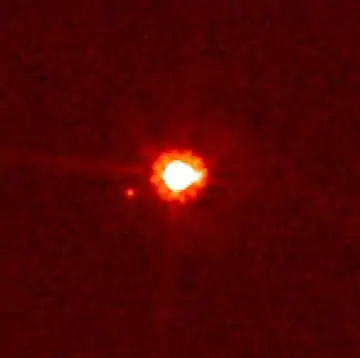 | Eris | I (1) | 350±60[7] | 37,273±64 | 15.786 | 2005 | 2005 | Brown, Rabinowitz, Trujillo et al. | Synchronous rotation (Binary) | [159] |
See also
- List of exomoon candidates
- Lists of exoplanets
- List of dwarf planets
- List of Solar System objects by size
- List of Solar System objects most distant from the Sun
- List of black holes
- Lists of stars
- Lists of stars by constellation
- List of IAU designated constellations
- List of multiplanetary systems
- List of galaxies
- List of largest cosmic structures
- Lists of astronomical objects
References
 Media related to Natural satellites at Wikimedia Commons
Media related to Natural satellites at Wikimedia Commons
- Ice in the Solar System – NASA
- Warell, J.; Karlsson, O. (2007). "A search for natural satellites of Mercury". Planetary and Space Science. 55 (14): 2037–2041. Bibcode:2007P&SS...55.2037W. doi:10.1016/j.pss.2007.06.004.
- "Solar System Exploration: Planets: Venus: Moons". NASA. Archived from the original on 11 February 2016. Retrieved 16 March 2008.
- Sheppard, Scott; et al. (2004). "A Survey for Outer Satellites of Mars: Limits to Completeness". The Astronomical Journal. 128 (5): 2542–2546. arXiv:astro-ph/0409522. Bibcode:2004AJ....128.2542S. doi:10.1086/424541. S2CID 45681283.
- Buie, Marc W.; Grundy, William M.; Young, Eliot F.; Young, Leslie A.; Stern, S. Alan (2006). "Orbits and Photometry of Pluto's Satellites: Charon, S/2005 P1, and S/2005 P2". The Astronomical Journal. 132 (1): 290–298. arXiv:astro-ph/0512491. Bibcode:2006AJ....132..290B. doi:10.1086/504422. S2CID 119386667.. a, i, e per JPL (site updated 2008 Aug 25)
- Bieryla, Allyson; Parker, J. W. (December 2006). "Search for Satellites around Ceres". 2007 AAS/AAPT Joint Meeting, American Astronomical Society Meeting 209, #25.02; Bulletin of the American Astronomical Society. 38: 933. Bibcode:2006AAS...209.2502B.
- Johnston, W. R. (30 December 2008). "(136199) Eris and Dysnomia". Johnston's Archive. Retrieved 1 December 2016.
- Dumas, C.; Carry, B.; Hestroffer, D.; Merlin, F. (2011). "High-contrast observations of (136108) Haumea". Astronomy & Astrophysics. 528: A105. arXiv:1101.2102. Bibcode:2011A&A...528A.105D. doi:10.1051/0004-6361/201015011. S2CID 119226136.
- Daniel W. E. Green (22 February 2007). "IAUC 8812: Sats OF 2003 AZ_84, (50000), (55637), (90482)". IAU Circular. Archived from the original on 19 July 2011. Retrieved 5 July 2011.
- Johnston, Wm. Robert (1 October 2022). "Asteroids with Satellites". Johnston's Archive. Retrieved 23 October 2022.
- Wieczorek, M.; et al. (2006). "The constitution and structure of the lunar interior". Reviews in Mineralogy and Geochemistry. 60 (1): 221–364. Bibcode:2006RvMG...60..221W. doi:10.2138/rmg.2006.60.3. S2CID 130734866.
- "Notes: The Satellites of Mars". The Observatory. 1 (6): 181–185. 20 September 1877. Bibcode:1877Obs.....1..181. Retrieved 9 March 2008.
- "Planetary Satellite Physical Parameters". JPL, NASA. 19 February 2015. Retrieved 1 February 2016., and references therein.
- "Planetary Satellite Mean Orbital Parameters". JPL, NASA. 23 August 2013. Retrieved 1 February 2016., and references therein.
- Showman, Adam P.; Malhotra, Renu (1999). "The Galilean Satellites" (PDF). Science. 286 (5437): 77–84. doi:10.1126/science.286.5437.77. PMID 10506564.
- Barnard, E. E. (1892). "Discovery and Observation of a Fifth Satellite to Jupiter". Astronomical Journal. 12: 81–85. Bibcode:1892AJ.....12...81B. doi:10.1086/101715.
- Crommelin, A. C. D. (10 March 1905). "Provisional Elements of Jupiter's Satellite VI". Monthly Notices of the Royal Astronomical Society. 65 (5): 524–527. Bibcode:1905MNRAS..65..524C. doi:10.1093/mnras/65.5.524.
- Porco, Carolyn C.; et al. (March 2003). "Cassini Imaging of Jupiter's Atmosphere, Satellites, and Rings". Science. 299 (5612): 1541–1547. Bibcode:2003Sci...299.1541P. doi:10.1126/science.1079462. PMID 12624258. S2CID 20150275.
- Perrine, C. D. (1905). "The Seventh Satellite of Jupiter". Publications of the Astronomical Society of the Pacific. 17 (101): 62–63. Bibcode:1905PASP...17...56.. doi:10.1086/121624. JSTOR 40691209.
- Melotte, P. J. (1908). "Note on the Newly Discovered Eighth Satellite of Jupiter, Photographed at the Royal Observatory, Greenwich". Monthly Notices of the Royal Astronomical Society. 68 (6): 456–457. Bibcode:1908MNRAS..68..456.. doi:10.1093/mnras/68.6.456.
- Nicholson, S. B. (1914). "Discovery of the Ninth Satellite of Jupiter". Publications of the Astronomical Society of the Pacific. 26 (1): 197–198. Bibcode:1914PASP...26..197N. doi:10.1086/122336. PMID 16586574.
- Nicholson, S.B. (1938). "Two New Satellites of Jupiter". Publications of the Astronomical Society of the Pacific. 50 (297): 292–293. Bibcode:1938PASP...50..292N. doi:10.1086/124963. S2CID 120216615.
- Nicholson, S. B. (1951). "An unidentified object near Jupiter, probably a new satellite". Publications of the Astronomical Society of the Pacific. 63 (375): 297–299. Bibcode:1951PASP...63..297N. doi:10.1086/126402.
- Kowal, C. T.; Aksnes, K.; Marsden, B. G.; Roemer, E. (1974). "Thirteenth satellite of Jupiter". Astronomical Journal. 80: 460–464. Bibcode:1975AJ.....80..460K. doi:10.1086/111766.
- Synnott, S.P. (1980). "1979J2: The Discovery of a Previously Unknown Jovian Satellite". Science. 210 (4471): 786–788. Bibcode:1980Sci...210..786S. doi:10.1126/science.210.4471.786. ISSN 0036-8075. JSTOR 1684562. PMID 17739548.
- Jewitt, D. C.; Danielson, G.E.; Synnott, S.P. (1979). "Discovery of a New Jupiter Satellite". Science. 206 (4421): 951. Bibcode:1979Sci...206..951J. doi:10.1126/science.206.4421.951. ISSN 0036-8075. JSTOR 1749286. PMID 17733911. S2CID 6391249.
- Synnott, S.P. (1981). "1979J3: Discovery of a Previously Unknown Satellite of Jupiter". Science. 212 (4501): 1392. Bibcode:1981Sci...212.1392S. doi:10.1126/science.212.4501.1392. ISSN 0036-8075. JSTOR 1686790. PMID 17746259.
- "IAUC 7460: S/1999 J 1". 20 July 2000. Retrieved 8 January 2011.
- "IAUC 2845: Probable New Satellite of Jupiter". 3 October 1975. Retrieved 8 January 2011.
- "IAUC 7525: S/1975 J 1 = S/2000 J 1". 25 November 2000. Retrieved 8 January 2011.
- "IAUC 7555: Satellites of Jupiter". 5 January 2001. Retrieved 8 January 2011.
- "IAUC 7900: Satellites of Jupiter". 16 May 2002. Retrieved 8 January 2011.
- "Jupiter's Known Satellites". Archived from the original on 18 March 2015. Retrieved 25 March 2016.
- "MPEC 2020-V19: S/2003 J 9". Minor Planet Electronic Circular. Minor Planet Center. 5 November 2020.
- "MPEC 2020-V10: S/2003 J 16". Minor Planet Electronic Circular. Minor Planet Center. 4 November 2020.
- "MPEC 2021-V333: S/2003 J 24". minorplanetcenter.net. Retrieved 16 November 2021.
- "MPEC 2022-Y69: S/2011 J 3". minorplanetcenter.net. 20 December 2023. Retrieved 21 December 2022.
- "MPEC 2023-A13: S/2016 J 3". minorplanetcenter.net. 5 January 2023. Retrieved 5 January 2023.
- "MPEC 2023-B96: S/2016 J 4". minorplanetcenter.net. 24 January 2023. Retrieved 24 January 2023.
- "MPEC 2022-Y68: S/2018 J 2". minorplanetcenter.net. 20 December 2023. Retrieved 21 December 2022.
- "MPEC 2023-B38: S/2018 J 3". minorplanetcenter.net. 19 January 2023. Retrieved 19 January 2023.
- "MPEC 2023-B51: S/2018 J 4". minorplanetcenter.net. 20 January 2023. Retrieved 20 January 2023.
- "MPEC 2023-A14: S/2021 J 1". minorplanetcenter.net. 5 January 2023. Retrieved 5 January 2023.
- "MPEC 2023-B37: S/2021 J 2". minorplanetcenter.net. 19 January 2023. Retrieved 19 January 2023.
- "MPEC 2023-B39: S/2021 J 3". minorplanetcenter.net. 19 January 2023. Retrieved 19 January 2023.
- "MPEC 2023-B40: S/2021 J 4". minorplanetcenter.net. 19 January 2023. Retrieved 19 January 2023.
- "MPEC 2023-B41: S/2021 J 5". minorplanetcenter.net. 19 January 2023. Retrieved 19 January 2023.
- "MPEC 2023-B50: S/2021 J 6". minorplanetcenter.net. 20 January 2023. Retrieved 20 January 2023.
- "MPEC 2023-D44: S/2022 J 1". minorplanetcenter.net. 22 February 2023. Retrieved 22 February 2023.
- "MPEC 2023-D45: S/2022 J 2". minorplanetcenter.net. 22 February 2023. Retrieved 22 February 2023.
- "MPEC 2023-D46: S/2022 J 3". minorplanetcenter.net. 22 February 2023. Retrieved 22 February 2023.
- C. Porco & the Cassini Imaging Team (18 July 2007). "S/ 2007 S 4". IAU Circular. 8857.
- "IAU Circular No. 9023". International Astronomical Union. 2009. Archived from the original on 1 May 2019. Retrieved 6 March 2009.
- Thomas, P. C.; Burns, J. A.; Tiscareno, M. S.; Hedman, M. M.; et al. (2013). "Saturn's Mysterious Arc-Embedded Moons: Recycled Fluff?" (PDF). 44th Lunar and Planetary Science Conference. p. 1598. Retrieved 21 May 2013.
- "MPEC 2019-T126: S/2004 S 20". minorplanetcenter.net. Retrieved 11 October 2019.
- "MPEC 2019-T128: S/2004 S 22". minorplanetcenter.net. Retrieved 11 October 2019.
- "MPEC 2019-T129: S/2004 S 23". minorplanetcenter.net. Retrieved 11 October 2019.
- "MPEC 2019-T132: S/2004 S 25". minorplanetcenter.net. Retrieved 11 October 2019.
- "MPEC 2019-T133: S/2004 S 26". minorplanetcenter.net. Retrieved 11 October 2019.
- "MPEC 2019-T134: S/2004 S 27". minorplanetcenter.net. Retrieved 11 October 2019.
- "MPEC 2019-T136: S/2004 S 29". minorplanetcenter.net. Retrieved 11 October 2019.
- "MPEC 2019-T137: S/2004 S 30". minorplanetcenter.net. Retrieved 11 October 2019.
- "MPEC 2019-T154: S/2004 S 32". minorplanetcenter.net. Retrieved 11 October 2019.
- "MPEC 2019-T155: S/2004 S 33". minorplanetcenter.net. Retrieved 11 October 2019.
- "MPEC 2019-T156: S/2004 S 34". minorplanetcenter.net. Retrieved 11 October 2019.
- "MPEC 2019-T157: S/2004 S 35". minorplanetcenter.net. Retrieved 11 October 2019.
- "MPEC 2019-T160: S/2004 S 38". minorplanetcenter.net. Retrieved 11 October 2019.
- "MPEC 2019-T127: S/2004 S 21". minorplanetcenter.net. Retrieved 11 October 2019.
- "MPEC 2019-T131: S/2004 S 24". minorplanetcenter.net. Retrieved 11 October 2019.
- "MPEC 2019-T135: S/2004 S 28". minorplanetcenter.net. Retrieved 11 October 2019.
- "MPEC 2019-T153: S/2004 S 31". minorplanetcenter.net. Retrieved 11 October 2019.
- "MPEC 2019-T158: S/2004 S 36". minorplanetcenter.net. Retrieved 11 October 2019.
- "MPEC 2019-T159: S/2004 S 37". minorplanetcenter.net. Retrieved 11 October 2019.
- "MPEC 2019-T161: S/2004 S 39". minorplanetcenter.net. Retrieved 11 October 2019.
- "MPEC 2023-J24: S/2004 S 40". minorplanetcenter.net. Retrieved 3 May 2023.
- "MPEC 2023-J37: S/2004 S 41". minorplanetcenter.net. Retrieved 6 May 2023.
- "MPEC 2023-J41: S/2004 S 42". minorplanetcenter.net. Retrieved 6 May 2023.
- "MPEC 2023-J45: S/2004 S 43". minorplanetcenter.net. Retrieved 7 May 2023.
- "MPEC 2023-J46: S/2004 S 44". minorplanetcenter.net. Retrieved 7 May 2023.
- "MPEC 2023-J47: S/2004 S 45". minorplanetcenter.net. Retrieved 7 May 2023.
- "MPEC 2023-J60: S/2004 S 46". minorplanetcenter.net. Retrieved 8 May 2023.
- "MPEC 2023-J62: S/2004 S 47". minorplanetcenter.net. Retrieved 8 May 2023.
- "MPEC 2023-J166: S/2004 S 48". minorplanetcenter.net. Retrieved 15 May 2023.
- "MPEC 2023-J168: S/2004 S 49". minorplanetcenter.net. Retrieved 15 May 2023.
- "MPEC 2023-J169: S/2004 S 50". minorplanetcenter.net. Retrieved 15 May 2023.
- "MPEC 2023-J177: S/2004 S 51". minorplanetcenter.net. Retrieved 15 May 2023.
- "MPEC 2023-J179: S/2004 S 52". minorplanetcenter.net. Retrieved 15 May 2023.
- "MPEC 2023-K03: S/2004 S 53". minorplanetcenter.net. Retrieved 16 May 2023.
- "MPEC 2023-J79: S/2005 S 4". minorplanetcenter.net. Retrieved 10 May 2023.
- "MPEC 2023-J85: S/2005 S 5". minorplanetcenter.net. Retrieved 10 May 2023.
- "MPEC 2023-J22: S/2006 S 9". minorplanetcenter.net. Retrieved 3 May 2023.
- "MPEC 2023-J42: S/2006 S 10". minorplanetcenter.net. Retrieved 6 May 2023.
- "MPEC 2023-J48: S/2006 S 11". minorplanetcenter.net. Retrieved 7 May 2023.
- "MPEC 2023-J49: S/2006 S 12". minorplanetcenter.net. Retrieved 7 May 2023.
- "MPEC 2023-J56: S/2006 S 13". minorplanetcenter.net. Retrieved 8 May 2023.
- "MPEC 2023-J64: S/2006 S 14". minorplanetcenter.net. Retrieved 8 May 2023.
- "MPEC 2023-J163: S/2006 S 15". minorplanetcenter.net. Retrieved 15 May 2023.
- "MPEC 2023-J164: S/2006 S 16". minorplanetcenter.net. Retrieved 15 May 2023.
- "MPEC 2023-J165: S/2006 S 17". minorplanetcenter.net. Retrieved 15 May 2023.
- "MPEC 2023-J170: S/2006 S 18". minorplanetcenter.net. Retrieved 15 May 2023.
- "MPEC 2023-J176: S/2006 S 19". minorplanetcenter.net. Retrieved 15 May 2023.
- "MPEC 2023-K118: S/2006 S 20". minorplanetcenter.net. Retrieved 23 May 2023.
- "MPEC 2023-J34: S/2007 S 5". minorplanetcenter.net. Retrieved 5 May 2023.
- "MPEC 2023-J40: S/2007 S 6". minorplanetcenter.net. Retrieved 6 May 2023.
- "MPEC 2023-J80: S/2007 S 7". minorplanetcenter.net. Retrieved 10 May 2023.
- "MPEC 2023-J81: S/2007 S 8". minorplanetcenter.net. Retrieved 10 May 2023.
- "MPEC 2023-K02: S/2007 S 9". minorplanetcenter.net. Retrieved 16 May 2023.
- "IAU Circular No. 9091". International Astronomical Union. 2009. Archived from the original on 12 June 2018. Retrieved 17 January 2010.
- "MPEC 2021-W14: S/2019 S 1". minorplanetcenter.net. Retrieved 16 November 2021.
- "MPEC 2023-J25: S/2019 S 2". minorplanetcenter.net. Retrieved 3 May 2023.
- "MPEC 2023-J26: S/2019 S 3". minorplanetcenter.net. Retrieved 3 May 2023.
- "MPEC 2023-J36: S/2019 S 4". minorplanetcenter.net. Retrieved 5 May 2023.
- "MPEC 2023-J43: S/2019 S 5". minorplanetcenter.net. Retrieved 6 May 2023.
- "MPEC 2023-N12: S/2019 S 6". minorplanetcenter.net. Retrieved 3 July 2023.
- "MPEC 2023-J57: S/2019 S 7". minorplanetcenter.net. Retrieved 8 May 2023.
- "MPEC 2023-J58: S/2019 S 8". minorplanetcenter.net. Retrieved 8 May 2023.
- "MPEC 2023-J59: S/2019 S 9". minorplanetcenter.net. Retrieved 8 May 2023.
- "MPEC 2023-J61: S/2019 S 10". minorplanetcenter.net. Retrieved 8 May 2023.
- "MPEC 2023-J63: S/2019 S 11". minorplanetcenter.net. Retrieved 8 May 2023.
- "MPEC 2023-J67: S/2019 S 12". minorplanetcenter.net. Retrieved 9 May 2023.
- "MPEC 2023-J69: S/2019 S 13". minorplanetcenter.net. Retrieved 9 May 2023.
- "MPEC 2023-J83: S/2019 S 14". minorplanetcenter.net. Retrieved 10 May 2023.
- "MPEC 2023-J84: S/2019 S 15". minorplanetcenter.net. Retrieved 10 May 2023.
- "MPEC 2023-J171: S/2019 S 16". minorplanetcenter.net. Retrieved 15 May 2023.
- "MPEC 2023-J172: S/2019 S 17". minorplanetcenter.net. Retrieved 15 May 2023.
- "MPEC 2023-J173: S/2019 S 18". minorplanetcenter.net. Retrieved 15 May 2023.
- "MPEC 2023-J174: S/2019 S 19". minorplanetcenter.net. Retrieved 15 May 2023.
- "MPEC 2023-J175: S/2019 S 20". minorplanetcenter.net. Retrieved 15 May 2023.
- "MPEC 2023-K05: S/2019 S 21". minorplanetcenter.net. Retrieved 16 May 2023.
- "MPEC 2023-J21: S/2020 S 1". minorplanetcenter.net. Retrieved 3 May 2023.
- "MPEC 2023-J27: S/2020 S 2". minorplanetcenter.net. Retrieved 3 May 2023.
- "MPEC 2023-J35: S/2020 S 3". minorplanetcenter.net. Retrieved 5 May 2023.
- "MPEC 2023-J38: S/2020 S 4". minorplanetcenter.net. Retrieved 6 May 2023.
- "MPEC 2023-J39: S/2020 S 5". minorplanetcenter.net. Retrieved 6 May 2023.
- "MPEC 2023-J68: S/2020 S 6". minorplanetcenter.net. Retrieved 9 May 2023.
- "MPEC 2023-J82: S/2020 S 7". minorplanetcenter.net. Retrieved 10 May 2023.
- "MPEC 2023-J167: S/2020 S 8". minorplanetcenter.net. Retrieved 15 May 2023.
- "MPEC 2023-J178: S/2020 S 9". minorplanetcenter.net. Retrieved 15 May 2023.
- "MPEC 2023-K04: S/2020 S 10". minorplanetcenter.net. Retrieved 16 May 2023.
- Farkas-Takács, A.; Kiss, Cs.; Pál, A.; Molnár, L.; Szabó, Gy. M.; Hanyecz, O.; et al. (September 2017). "Properties of the Irregular Satellite System around Uranus Inferred from K2, Herschel, and Spitzer Observations". The Astronomical Journal. 154 (3): 13. arXiv:1706.06837. Bibcode:2017AJ....154..119F. doi:10.3847/1538-3881/aa8365. S2CID 118869078. 119.
- Kiss, C.; Pál, A.; Farkas-Takács, A. I.; Szabó, G. M.; Szabó, R.; Kiss, L. L.; et al. (April 2016). "Nereid from space: Rotation, size and shape analysis from K2, Herschel and Spitzer observations" (PDF). Monthly Notices of the Royal Astronomical Society. 457 (3): 2908–2917. arXiv:1601.02395. Bibcode:2016MNRAS.457.2908K. doi:10.1093/mnras/stw081. S2CID 54602372.
- Kelly Beatty (15 July 2013). "Neptune's Newest Moon". Sky & Telescope. Retrieved 8 March 2018.
- Grundy, W. M.; Noll, K. S.; Roe, H. G.; Buie, M. W.; Porter, S. B.; Parker, A. H.; Nesvorný, D.; Benecchi, S. D.; Stephens, D. C.; Trujillo, C. A. (2019). "Mutual Orbit Orientations of Transneptunian Binaries" (PDF). Icarus. 334: 62–78. Bibcode:2019Icar..334...62G. doi:10.1016/j.icarus.2019.03.035. ISSN 0019-1035. S2CID 133585837. Archived from the original (PDF) on 15 January 2020. Retrieved 26 November 2019.
- Johnston, Wm. Robert (20 September 2014). "(208996) 2003 AZ84". Johnston's Archive. Retrieved 16 January 2018.
- Showalter, M. R.; Hamilton, D. P. (20 July 2011). "New Satellite of (134340) Pluto: S/2011 (134340) 1". Central Bureau Electronic Telegrams. Central Bureau for Astronomical Telegrams. Retrieved 20 July 2011.
- "NASA's Hubble Discovers Another Moon Around Pluto". NASA. Retrieved 21 July 2011.
- "Hubble Discovers a Fifth Moon Orbiting Pluto". NASA. Archived from the original on 19 December 2016. Retrieved 13 July 2012.
- D. C. Fabrycky; M. J. Holman; D. Ragozzine; M. E. Brown; T. A. Lister; D. M. Terndrup; J. Djordjevic; E. F. Young; L. A. Young; R. R. Howell (2008). "Mutual Events of 2003 EL61 and its Inner Satellite". AAS DPS Conference 2008. 40: 36.08. Bibcode:2008DPS....40.3608F.
- Ragozzine, D.; Brown, M.E. (2009). "Orbits and Masses of the Satellites of the Dwarf Planet Haumea = 2003 EL61". The Astronomical Journal. 137 (6): 4766–4776. arXiv:0903.4213. Bibcode:2009AJ....137.4766R. doi:10.1088/0004-6256/137/6/4766. S2CID 15310444.
- Johnston, Wm. Robert (21 September 2014). "(50000) Quaoar and Weywot". Johnston's Archive. Retrieved 20 June 2023.
- Fraser, Wesley C.; Brown, Michael E. (May 2010). "Quaoar: A Rock in the Kuiper Belt". The Astrophysical Journal. 714 (2): 1547–1550. arXiv:1003.5911. Bibcode:2010ApJ...714.1547F. doi:10.1088/0004-637X/714/2/1547. S2CID 17386407.
- "Hubble Discovers Moon Orbiting the Dwarf Planet Makemake". hubblesite.org. 2016. Retrieved 27 April 2016.
- Parker, A. H.; Buie, M. W.; Grundy, W. M.; Noll, K. S. (25 April 2016). "Discovery of a Makemakean Moon". The Astrophysical Journal. 825 (1): L9. arXiv:1604.07461. Bibcode:2016ApJ...825L...9P. doi:10.3847/2041-8205/825/1/L9. S2CID 119270442.
- Grundy, W. M.; Porter, S. B.; Benecchi, S. D.; Roe, H. G.; Noll, K. S.; Trujillo, C. A.; Thirouin, A.; Stansberry, J. A.; Barker, E.; Levison, H. F. (1 September 2015). "The mutual orbit, mass, and density of the large transneptunian binary system Varda and Ilmarë". Icarus. 257: 130–138. arXiv:1505.00510. Bibcode:2015Icar..257..130G. doi:10.1016/j.icarus.2015.04.036. S2CID 44546400.
- Grundy, W. M.; Porter, S. B.; Benecchi, S. D.; Roe, H. G.; Noll, K. S.; Trujillo, C. A.; et al. (September 2015). "The mutual orbit, mass, and density of the large transneptunian binary system Varda and Ilmarë". Icarus. 257: 130–138. arXiv:1505.00510. Bibcode:2015Icar..257..130G. doi:10.1016/j.icarus.2015.04.036. S2CID 44546400.
- Johnston, Wm. Robert (27 May 2019). "(532037) 2013 FY27". Johnston's Archive. Retrieved 20 June 2023.
- Sheppard, Scott; Fernandez, Yanga; Moullet, Arielle (6 September 2018). "The Albedos, Sizes, Colors and Satellites of Dwarf Planets Compared with Newly Measured Dwarf Planet 2013 FY27". The Astronomical Journal. 156 (6): 270. arXiv:1809.02184. Bibcode:2018AJ....156..270S. doi:10.3847/1538-3881/aae92a. S2CID 119522310.
- Kiss, Csaba; Marton, Gabor; Parker, Alex H.; Grundy, Will; Farkas-Takacs, Aniko; Stansberry, John; Pal, Andras; Muller, Thomas; Noll, Keith S.; Schwamb, Megan E.; Barr, Amy C.; Young, Leslie A.; Vinko, Jozsef (October 2018). "The mass and density of the dwarf planet (225088) 2007 OR10". Icarus. 334: 3–10. arXiv:1903.05439. Bibcode:2018DPS....5031102K. doi:10.1016/j.icarus.2019.03.013. S2CID 119370310. 311.02.
Initial publication at the American Astronomical Society DPS meeting #50, with the publication ID 311.02 - Holler, Bryan J.; Grundy, William M.; Buie, Marc W.; Noll, Keith S. (February 2021). "The Eris/Dysnomia system I: The orbit of Dysnomia". Icarus. 355: 114130. arXiv:2009.13733. Bibcode:2021Icar..35514130H. doi:10.1016/j.icarus.2020.114130. S2CID 221995416. 114130.

